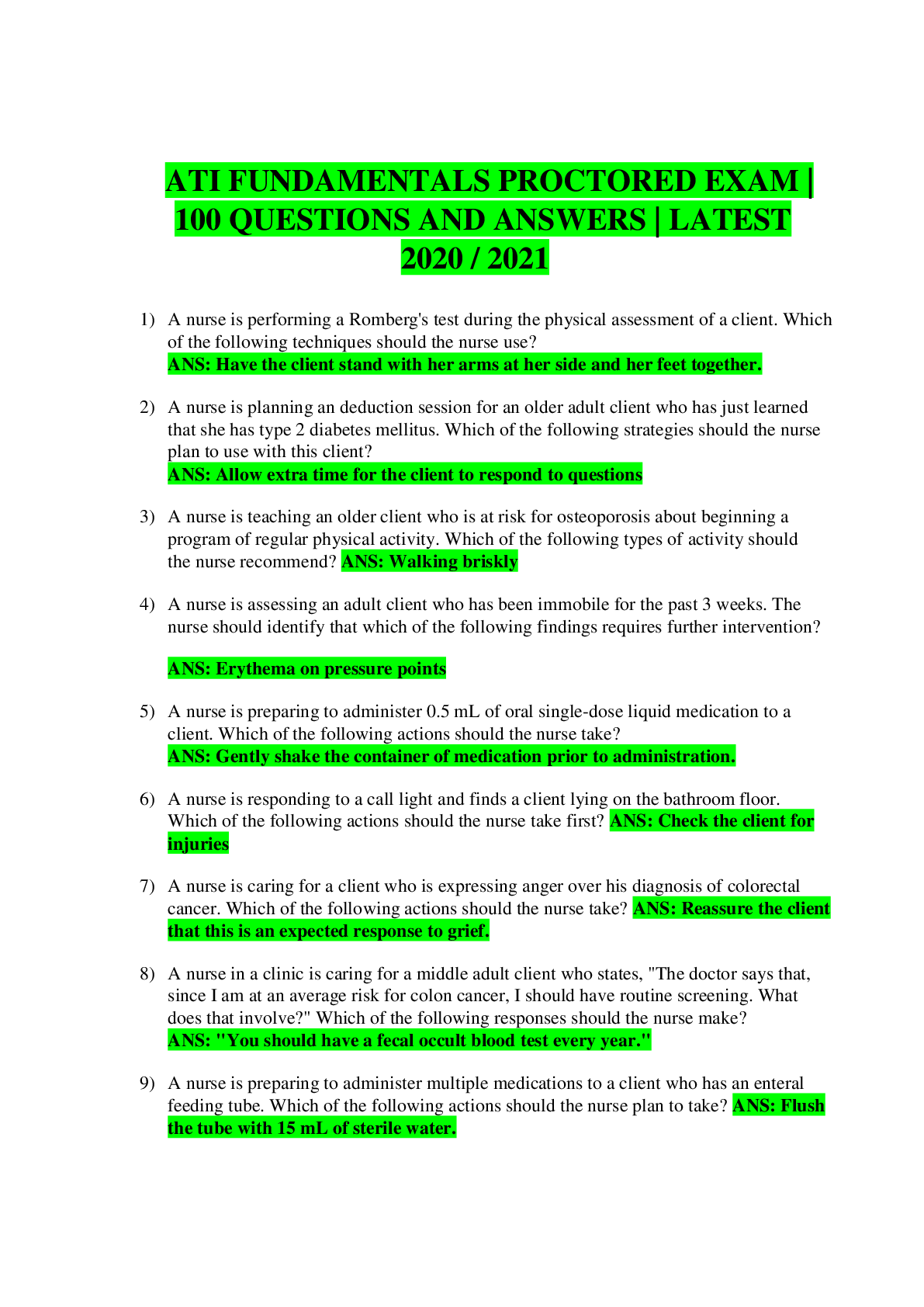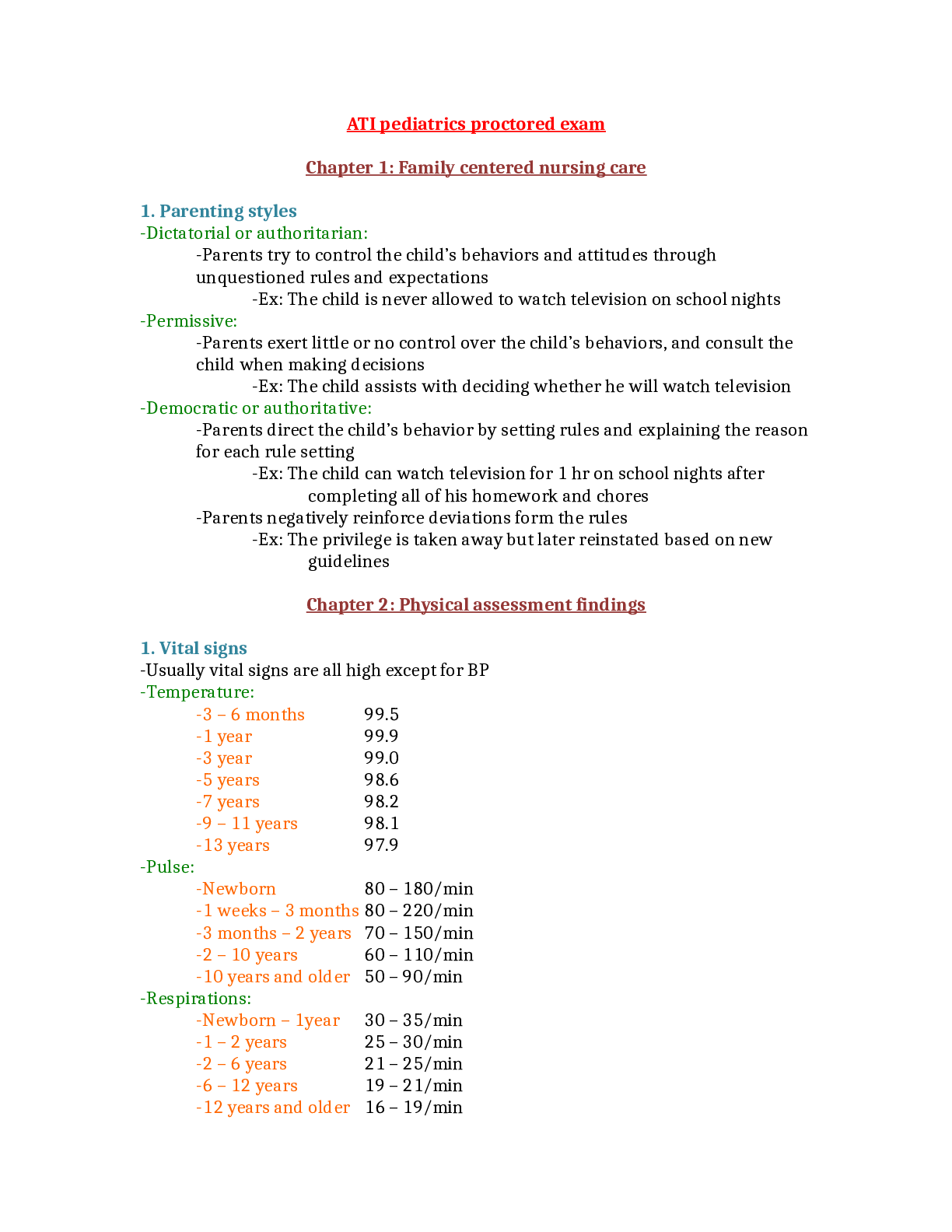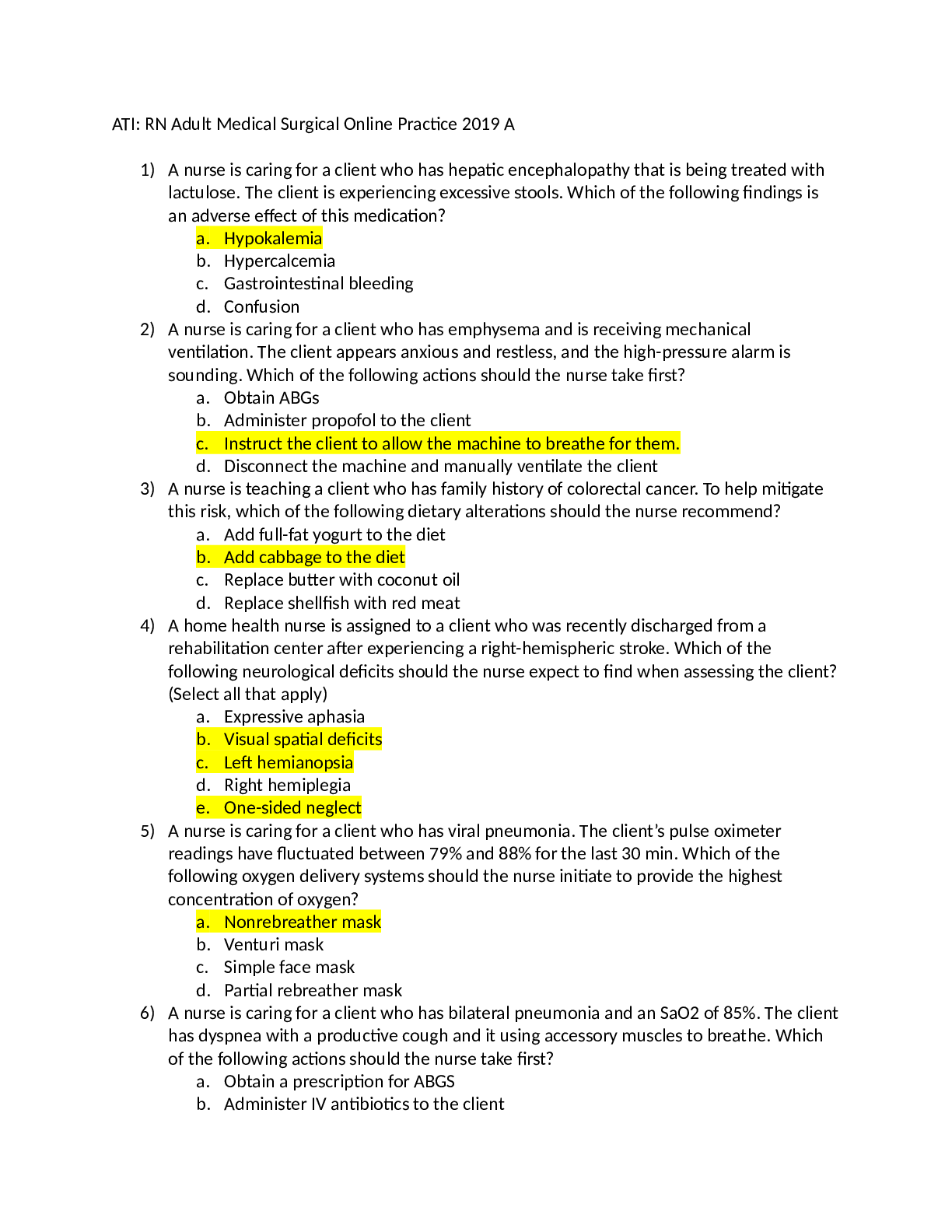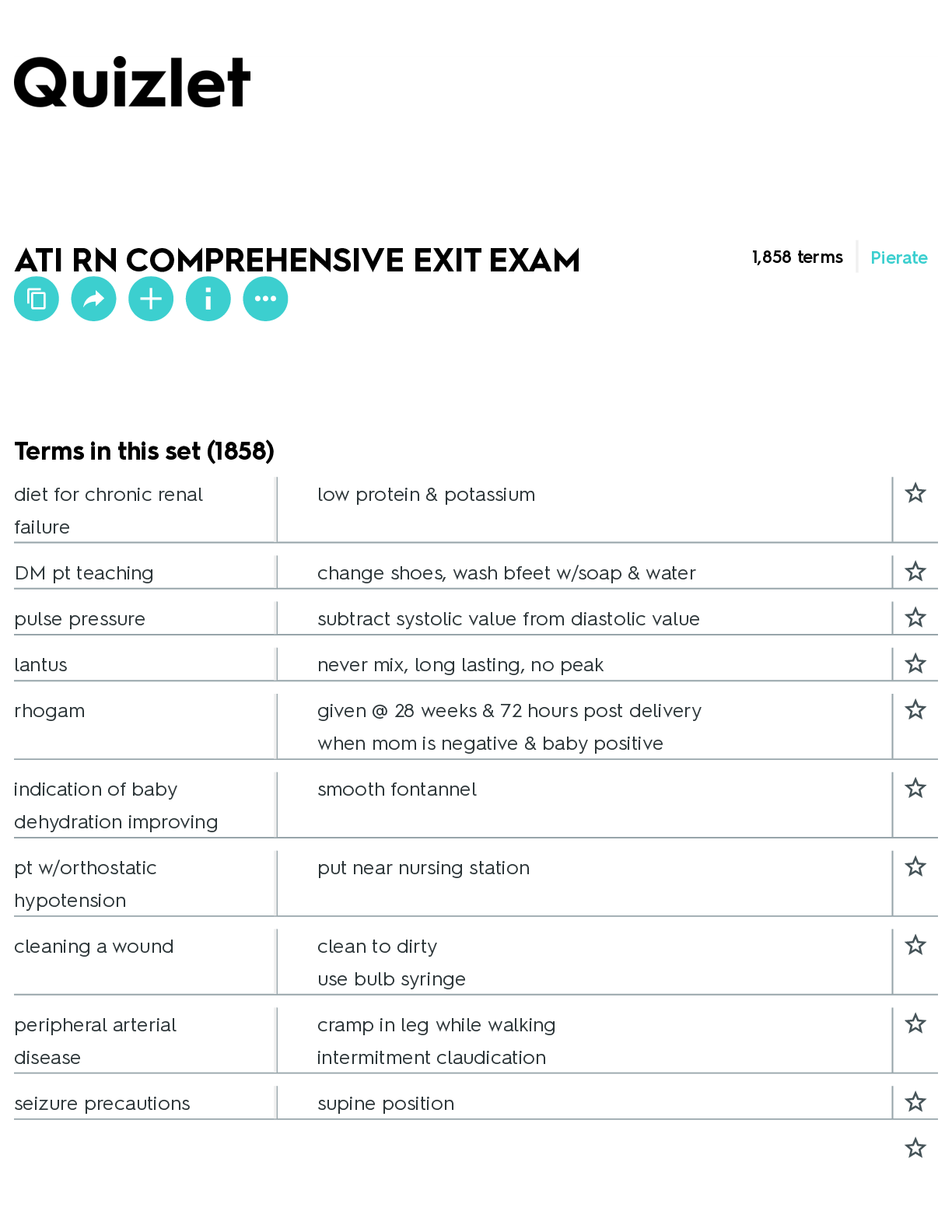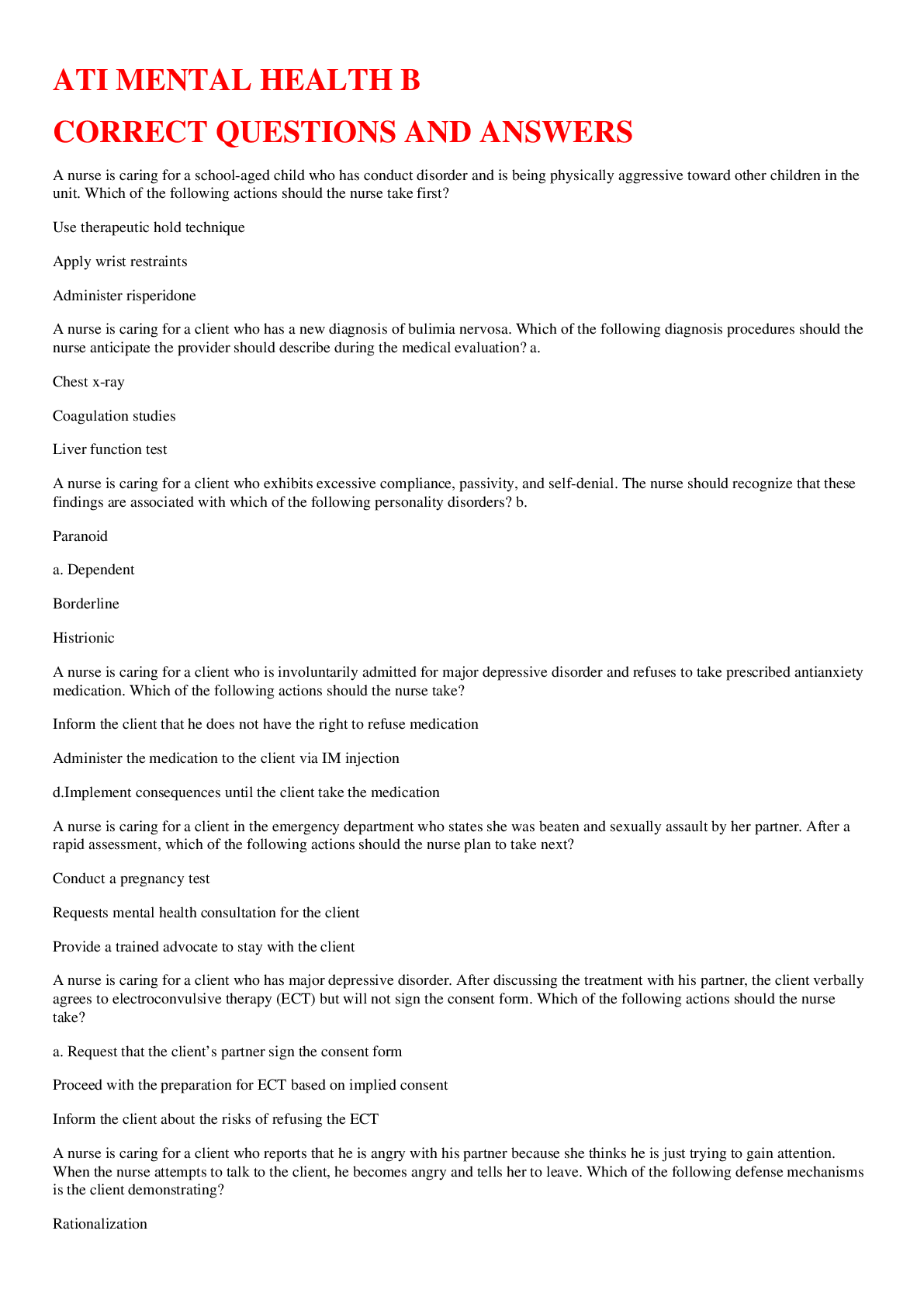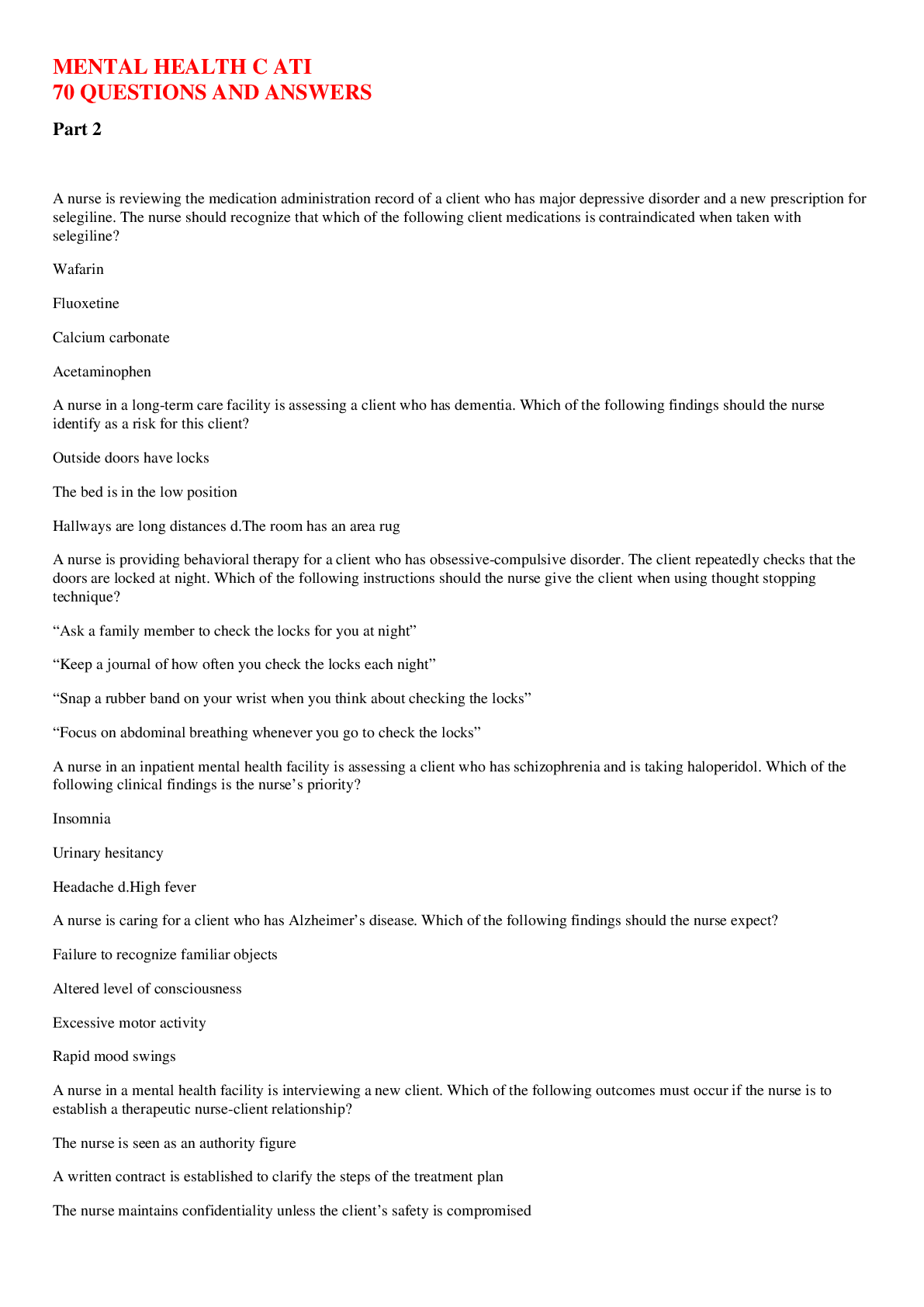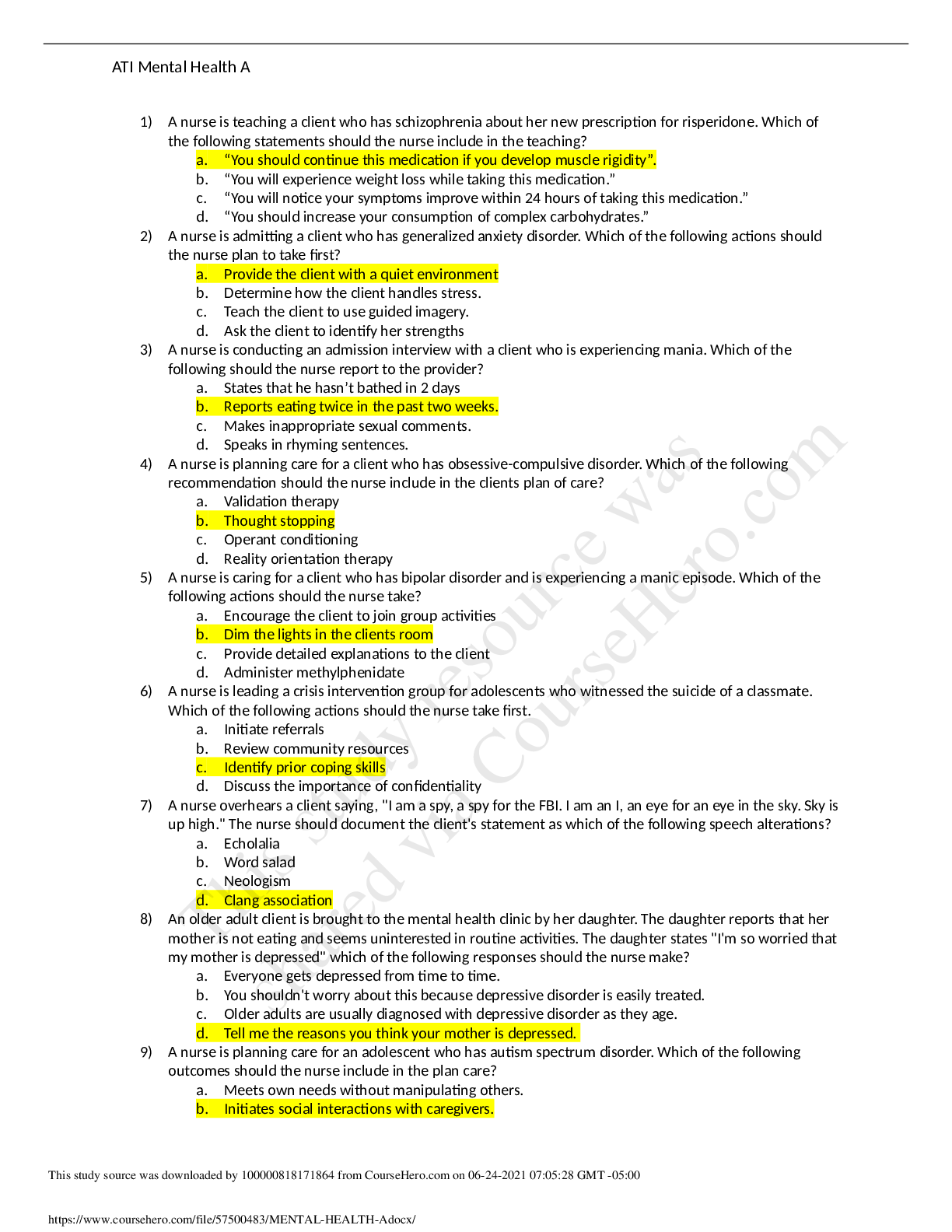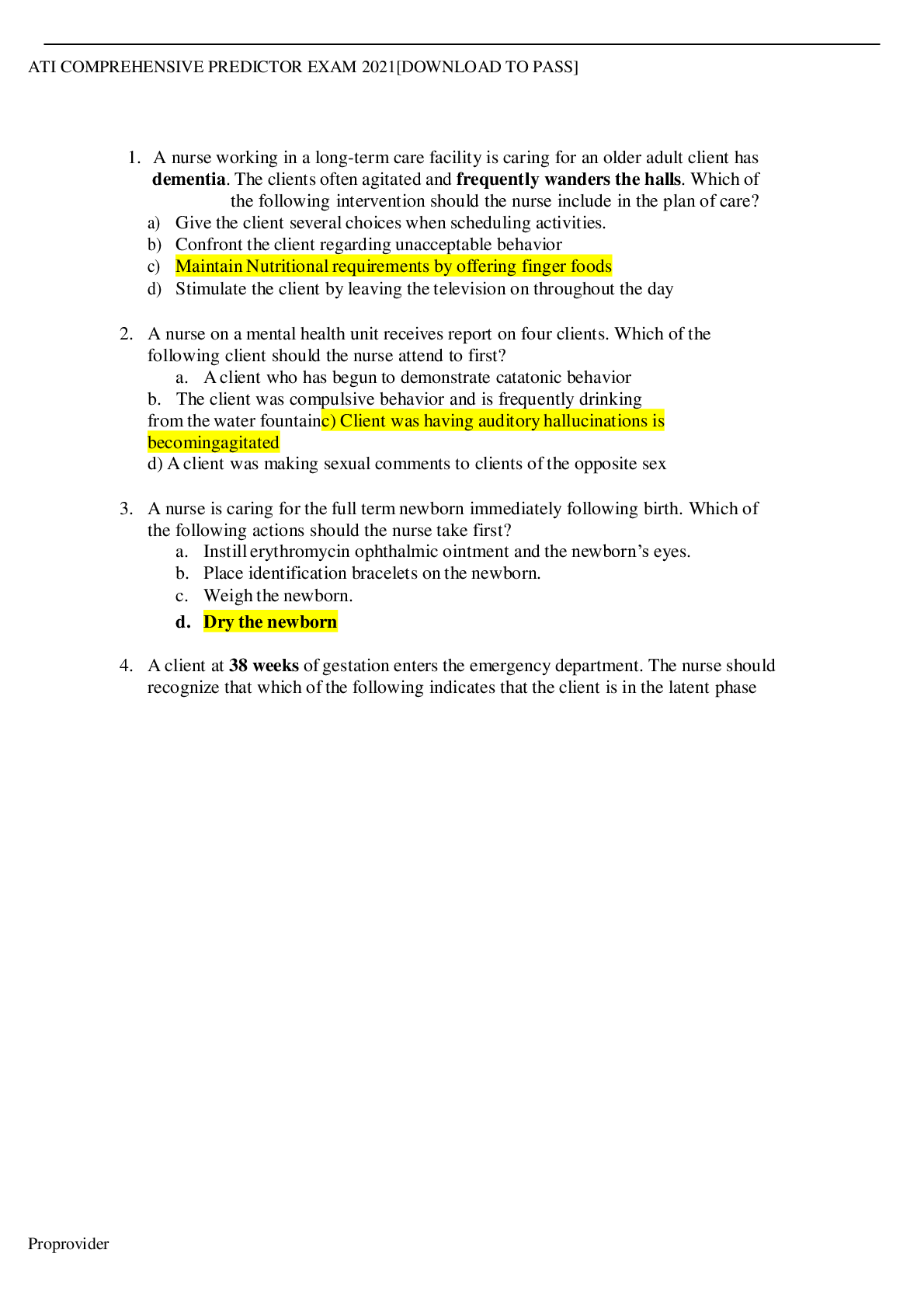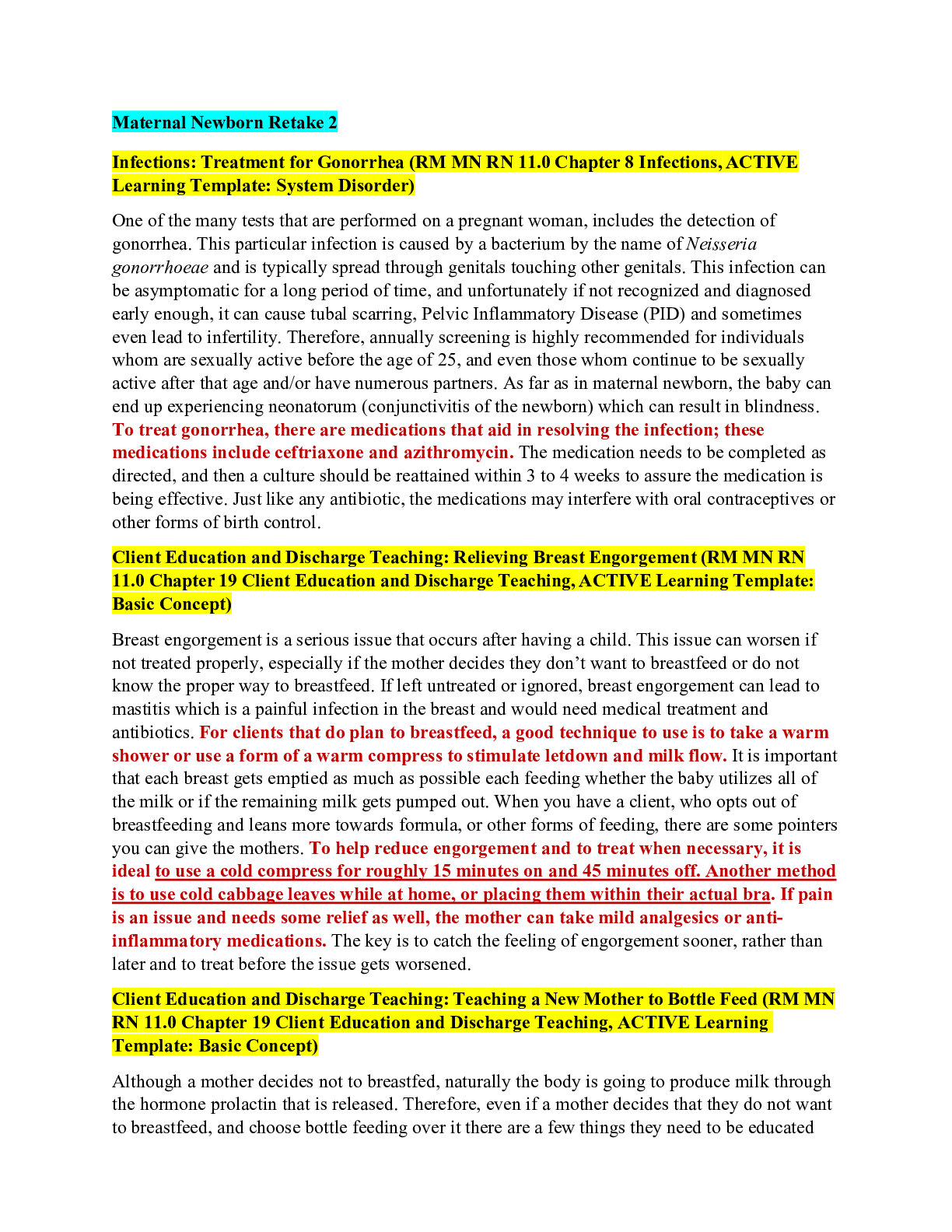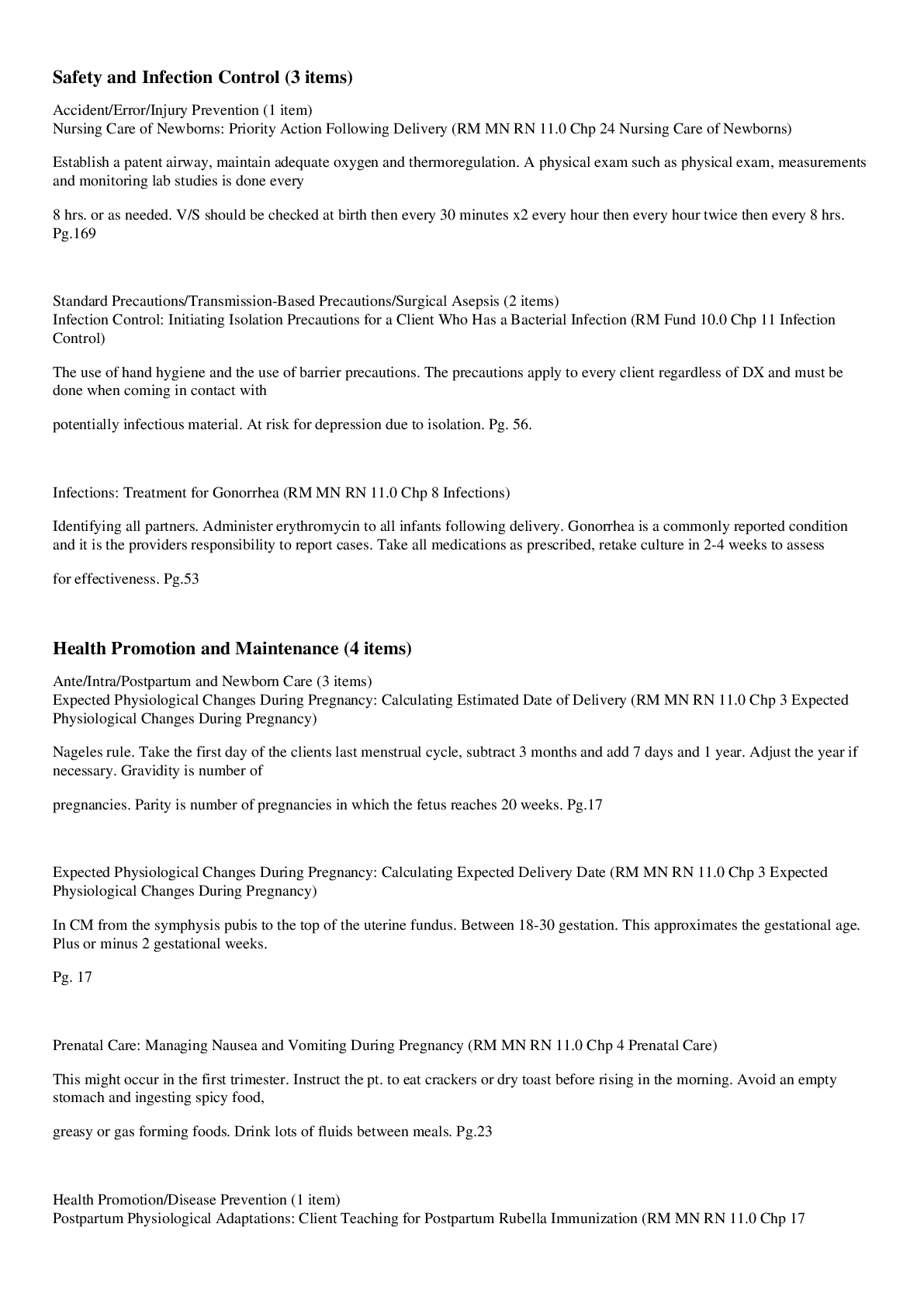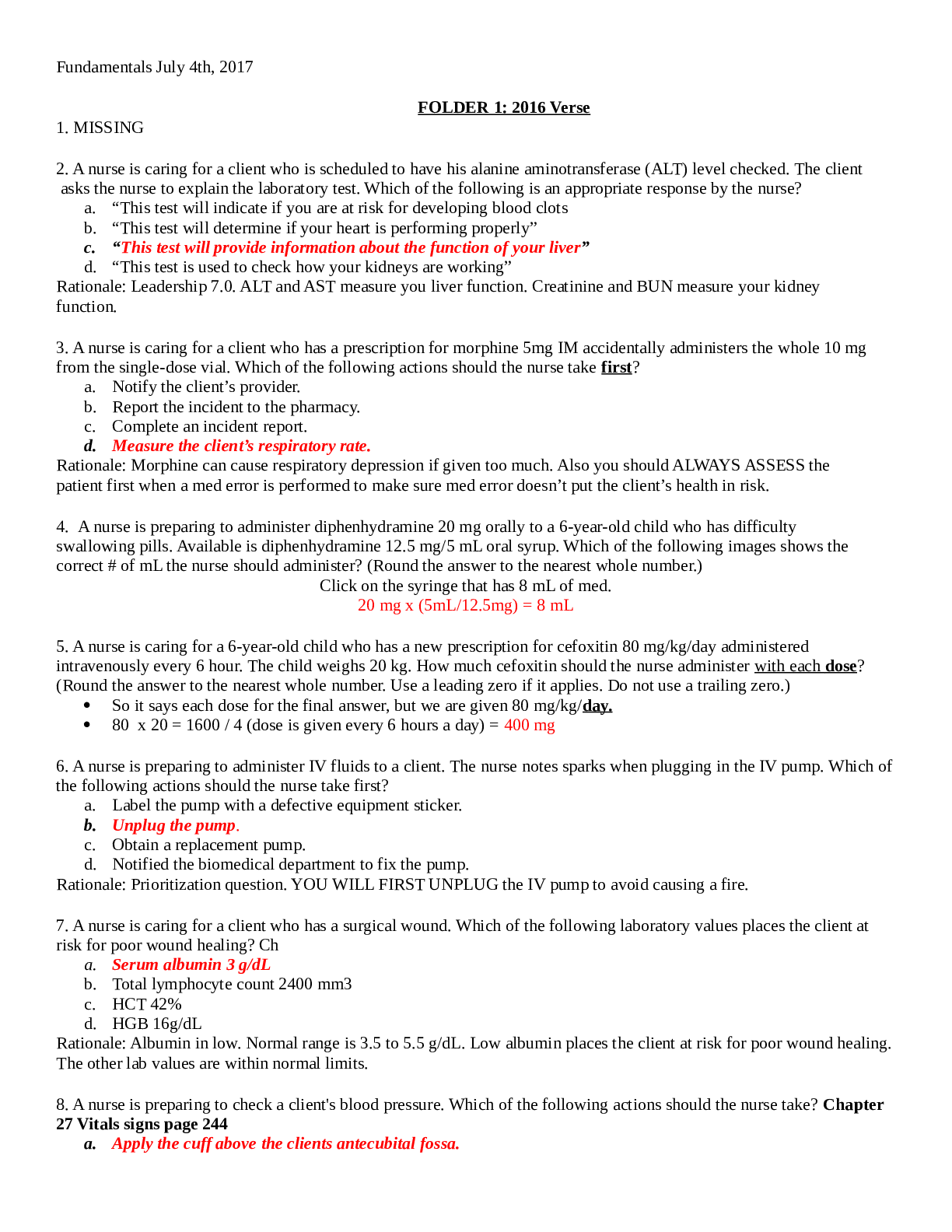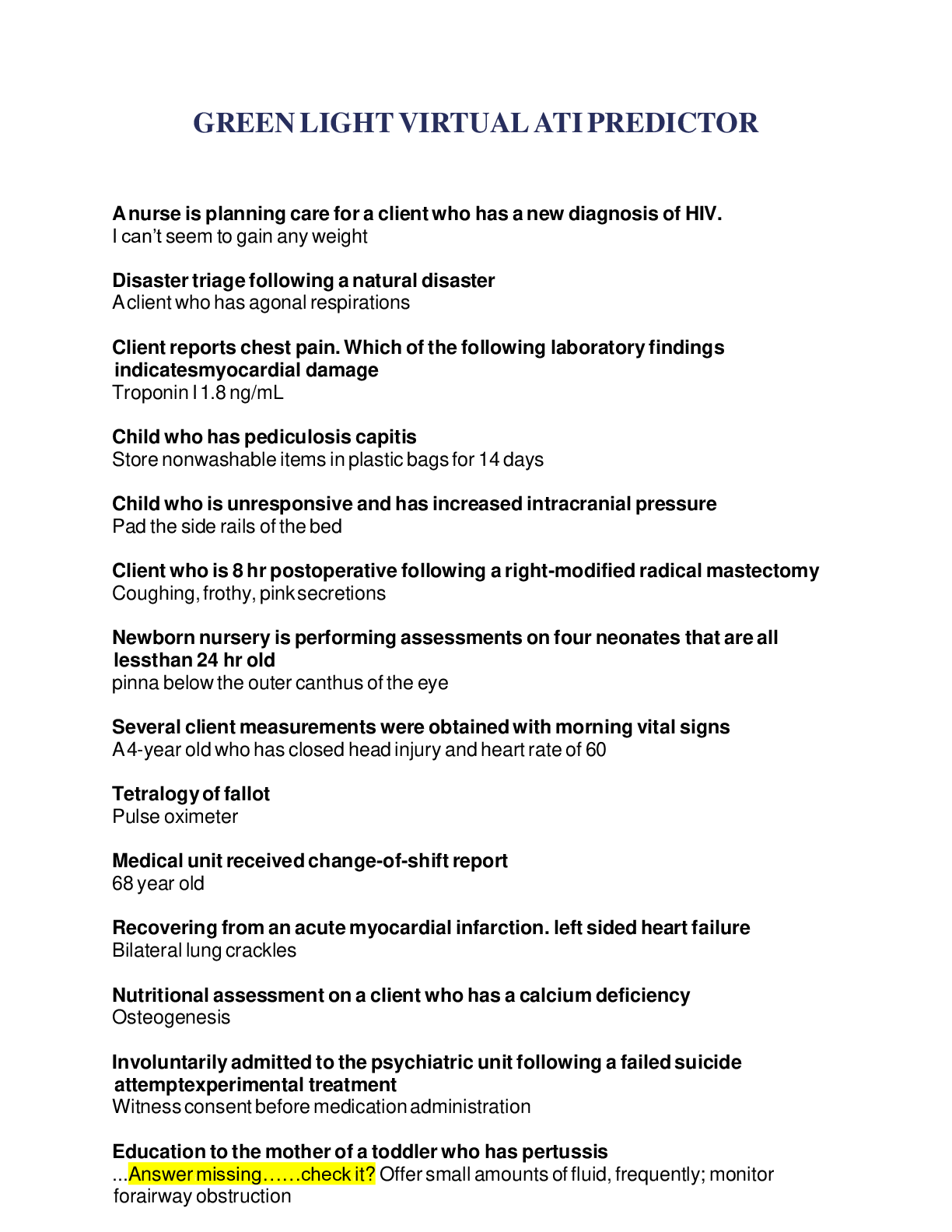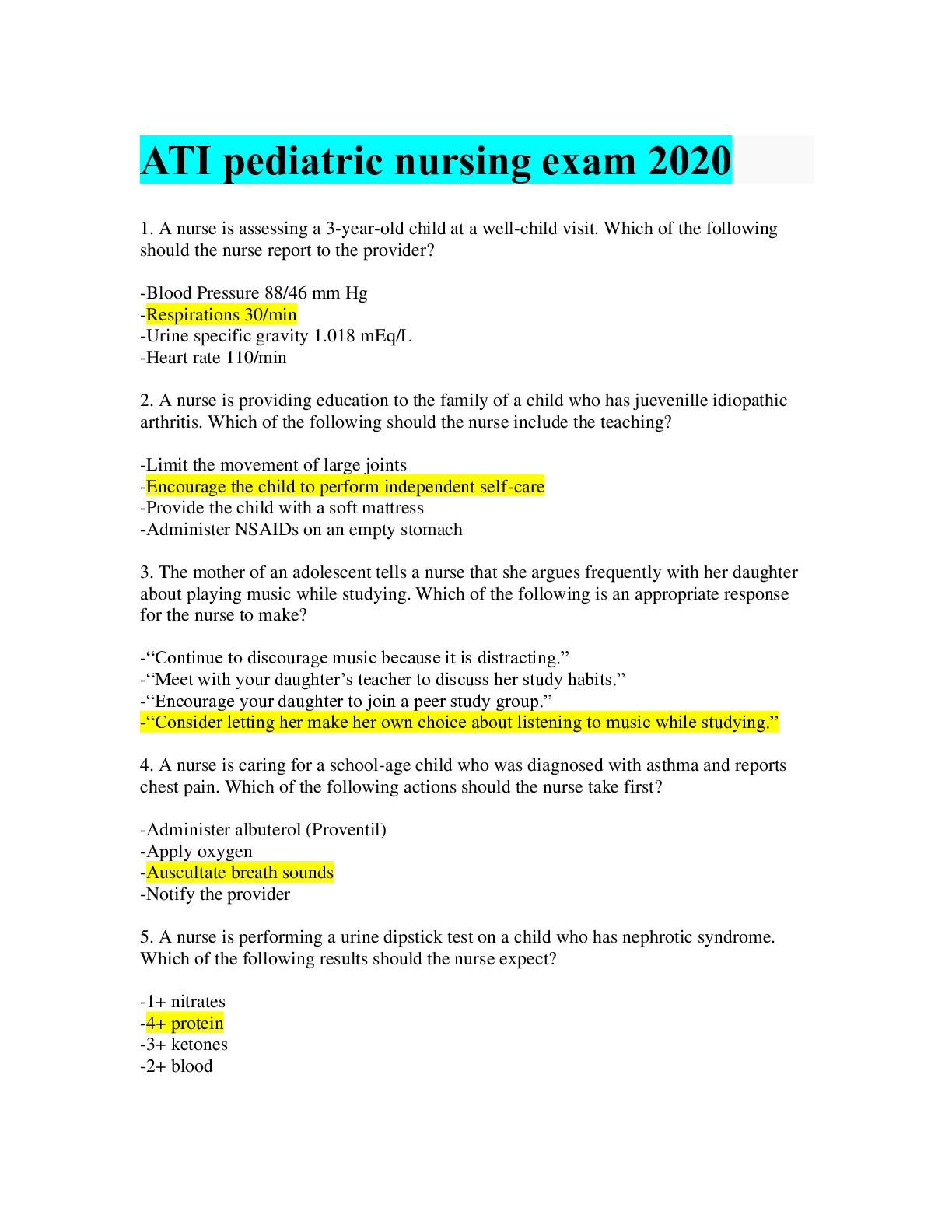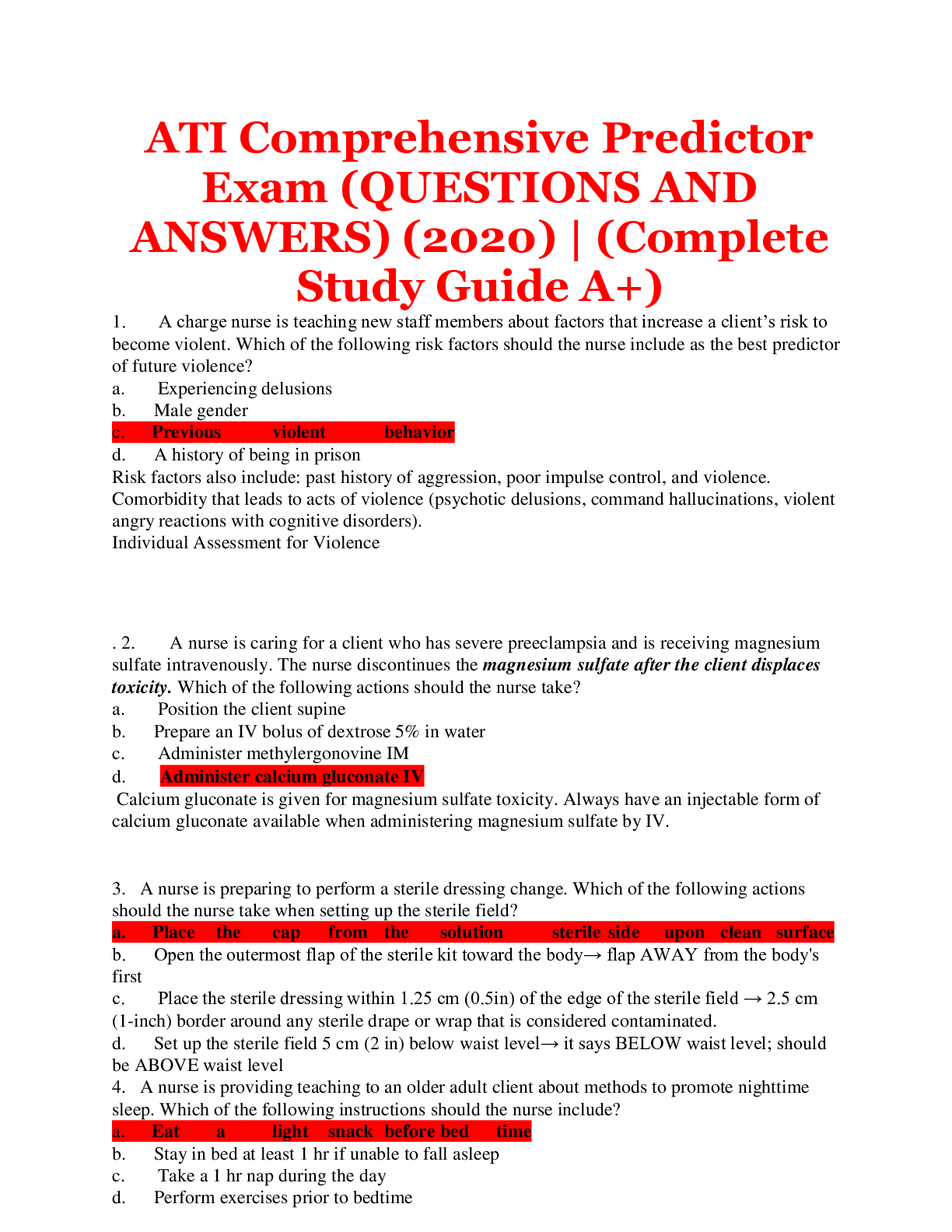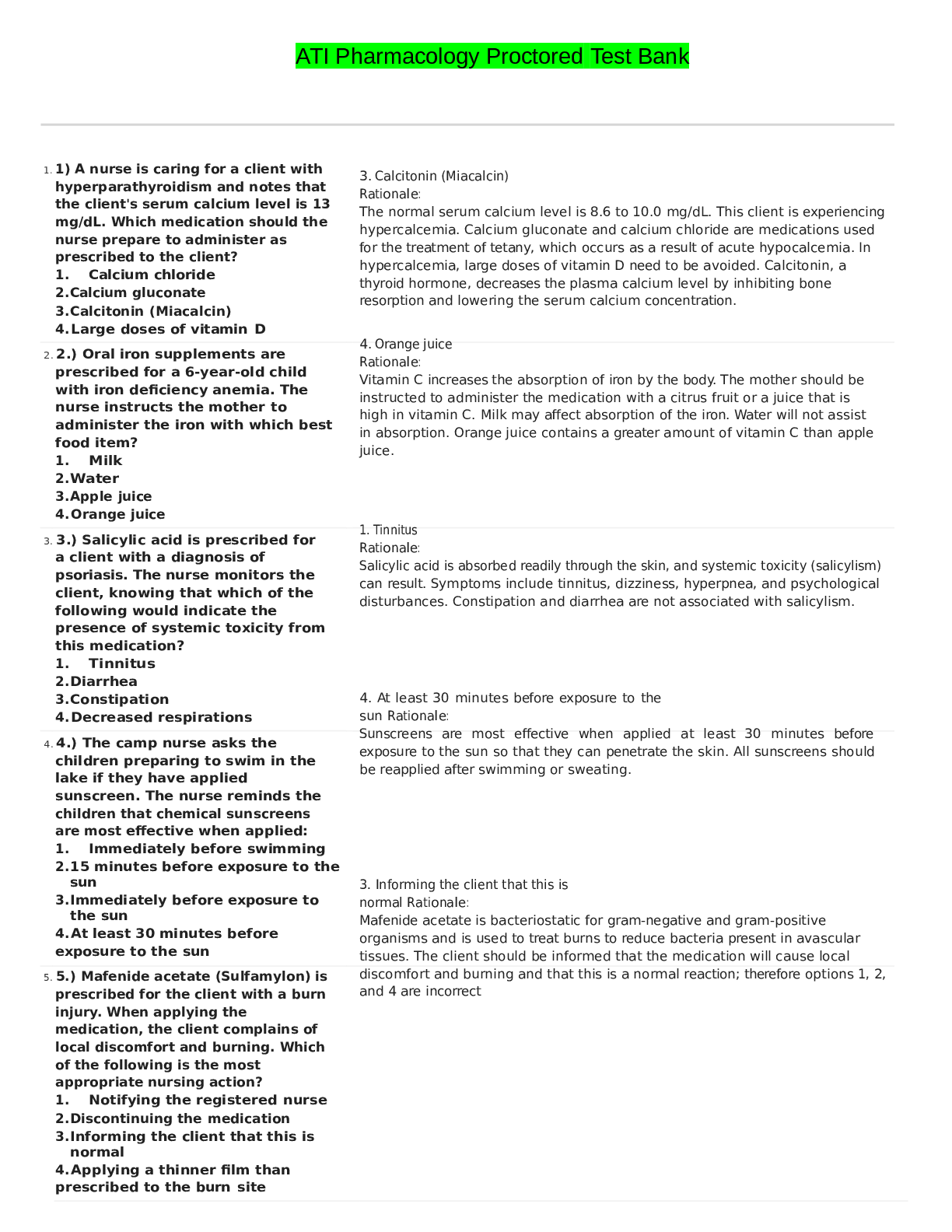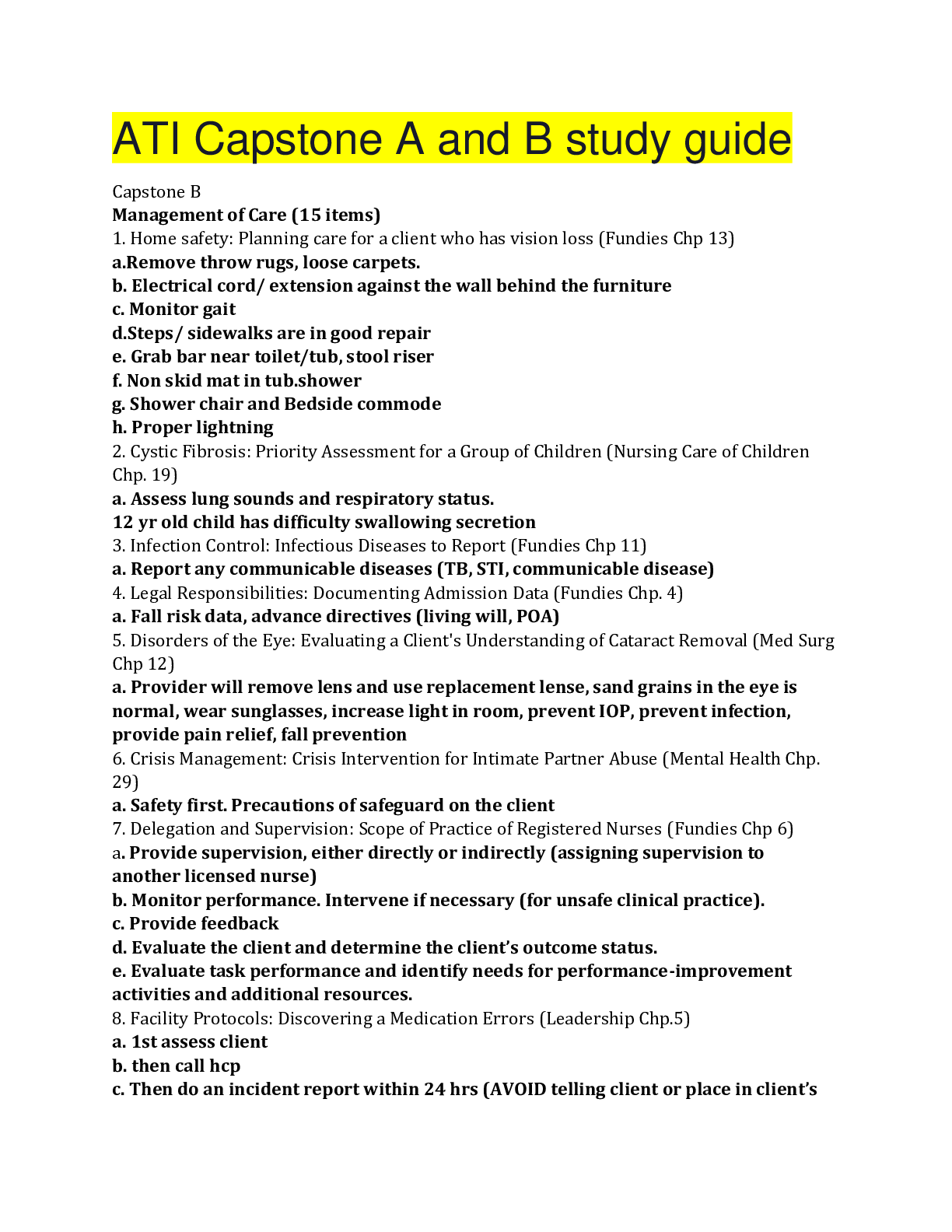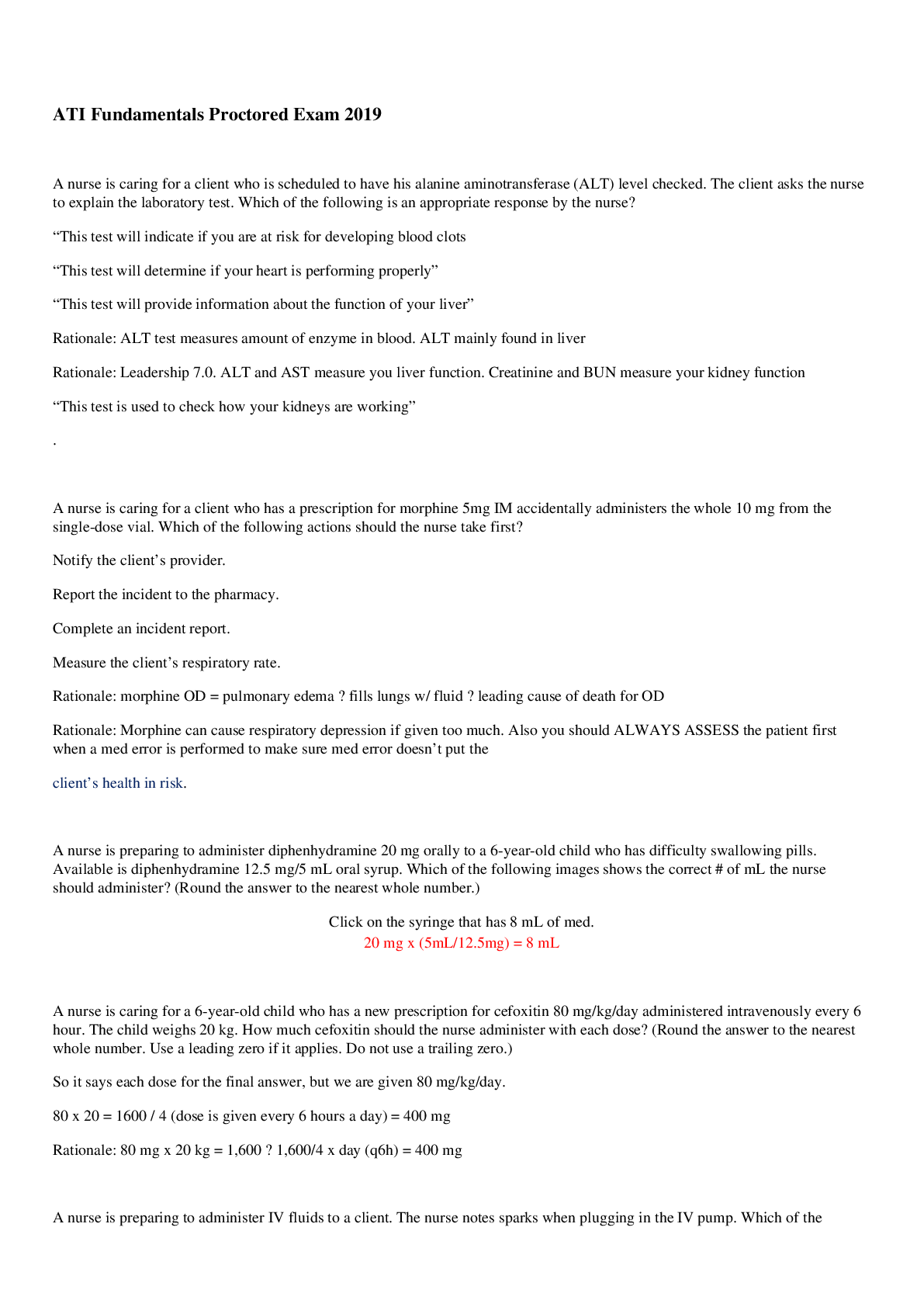*NURSING > QUESTIONS and ANSWERS > CHAMBERLAIN UNIVERSITY ATI Dosage Calculations Practice-Answer Key (All)
CHAMBERLAIN UNIVERSITY ATI Dosage Calculations Practice-Answer Key
Document Content and Description Below
ATI Dosage Calculations Practice-Answer Key CONVERTING POUNDS TO KILOGRAMS STEP OUTLINE VIEW For example, the client’s weight is 128 lb. Determine this client’s weight in kg.(Round to the tenth... .) STEP 1: What isthe unit of measurement you need to calculate?kg STEP 2: Set up an equation and solve for X, with X representing the amount ofkilograms. Cross multiply and solve for X.X = 58.1818 STEP 3: Round if necessary, using general rounding rules. You should also follow policies and procedures of your facility. For the purpose ofthis module, we will round to the tenth. Therefore, 58.1818 rounds to 58.2. STEP 4: Reassess to determine if the equivalent makes sense. If 1 kg = 2.2 lb, it makes sense that 128 lb = 58.2 kg. CONVERTING POUNDS TO KILOGRAMS STEP OUTLINE VIEW For example, the client’s weight is 96 lb. Determine this client’s weight in kg.(Round to the tenth.) STEP 1: What isthe unit of measurement you need to calculate?kg STEP 2: Set up an equation and solve for X, with X representing the amount ofkilograms. Cross multiply to solve for X.X = 43.6363 STEP 3: Round if necessary, using general rounding rules. You should also followpolicies and procedures of your facility. For the purpose of this module, we will round to the tenth. Therefore, 43.6363rounds to 43.6.STEP 4: Reassess to determine if the equivalent makes sense. If 1 kg = 2.2 lb, it makes sense that 128 lb = 43.6 kg. CONVERTING OUNCES TO POUNDS STEP OUTLINE VIEW For example, the client’s weight is 5 lb 4 oz. Determine this client’s weight in lb. (Round to thetenth.) STEP 1: What is the unit of measurement you need to calculate?lb STEP 2: Set up an equation and solve for X, with X representing the amount of pounds. Cross multiply to solve for X.X = 0.25 STEP 3: Round if necessary, using general rounding rules. You should also followpolicies and procedures of your facility. For the purpose of this module, we will round to the tenth. Therefore, 0.25 roundsto 0.3. STEP 4: Reassess to determine if the equivalent makes sense. If 1 lb = 16 oz, it makes sense that 4 oz = 0.3 lb. STEP 5: Remember to add the remainder weight. It is important not to forget therest of the client’s weight, which in this example is 5 lb. Therefore, 5 lb + 0.3 lb = 5.3 lb. CONVERTING OUNCES TO POUNDS STEP OUTLINE VIEW For example, the client’s weight is 21 lb 14 oz. Determine this client’s weight inpounds. (Round to the tenth.) STEP 1: What is the unit of measurement you need to calculate?lb STEP 2: Set up an equation and solve for X, with X representing the amount of lb. Cross multiply to solve for X.X = 0.875 STEP 3: Round if necessary, using general rounding rules. You should also follow policies and procedures of your facility. For the purpose of this module, we will roundto the tenth. Therefore, 0.875 rounds to 0.9. STEP 4: Reassess to determine if the equivalent makes sense. If 1 lb = 16 oz, it makes sense that 14 oz = 0.9 lb. STEP 5: Remember to add the remainder weight. It is important not to forget the rest of the client’s weight, which in this example is 21 lb. So 21 lb + 0.9 lb = 21.9 lb. CONVERTING OUNCES TO POUNDS TO KILOGRAMS STEP OUTLINE VIEW For example, convert a client’s weight from oz to lb, then from lb to kg. The client’s weight is 65lb 12 oz. (Round to the tenth.) STEP 1: What is the unit of measurement you need to calculate?lb STEP 2: Set up an equation and solve for X, with X representing the amount ofpounds. Cross multiply and solve for X.X = 0.75. STEP 3: Round if necessary, using general rounding rules. You should also followpolicies and procedures of your facility. For the purpose of this module, we will round to the tenth. Therefore, 0.75 roundsto 0.8. STEP 4: Reassess to determine if the equivalent makes sense. If 1 lb = 16 oz, it makes sense that 12 oz = 0.8 lb. STEP 5: Remember to add the remainder weight. It is important not to forget therest of the client’s weight, which in this example is 65 lb. So 65 lb + 0.8 lb = 65.8 lb. The client’s weight is 65.8 lb. Determine this client’s weight in kilograms. (Round tothe tenth.)STEP 6: What isthe unit of measurement you need to calculate?kg STEP 7: Set up an equation and solve for X, with X representing the amount ofkilograms. Cross multiply and solve for X.X = 29.9 STEP 8: Round if necessary, using general rounding rules. You should also followpolicies and procedures of your facility. For the purpose of this module, we will round to the tenth. In this example, thereis no reason to round your answer because it is already rounded to the tenth. STEP 9: Reassess to determine if the equivalent makes sense. If 1 kg = 2.2 lb, it makes sense that 65.8 lb = 29.9 kg. CONVERTING OUNCES TO POUNDS TO KILOGRAMS STEP OUTLINE VIEW For example, convert a client’s weight from oz to lb, then from lb to kg. The client’s weight is 33lb 8 oz. (Round to the tenth.) STEP 1: What is the unit of measurement you need to calculate?lb STEP 2: Set up an equation and solve for X, with X representing the amount of pounds. Cross multiply and solve for X.X = 0.5 STEP 3: Round if necessary, using general rounding rules. You should also followpolicies and procedures of your facility. For the purpose of this module, we will round to the tenth. In this example, thereis no reason to round your answer because it is already rounded to the tenth. STEP 4: Reassess to determine if the equivalent makes sense. If 1 lb = 16 oz, it makes sense that 8 oz = 0.5 lb.STEP 5: Remember to add the remainder weight. It is important not to forget therest of the client’s weight, which in this example is 33 lb. So 33 lb + 0.5 lb = 33.5 lb. The client’s weight is 33.5 pounds. Determine this client’s weight in kilograms.(Round to the tenth.) STEP 6: What isthe unit of measurement you need to calculate?kg STEP 7: Set up an equation and solve for X, with X representing the amount ofkilograms. Cross multiply and solve for X.X = 15.22 STEP 8: Round if necessary, using general rounding rules. You should also followpolicies and procedures of your facility. For the purpose of this module, we will round to the tenth. Therefore, 15.22rounds to 15.2. STEP 9: Reassess to determine if the equivalent makes sense. If 1 kg = 2.2 lb, it makes sense that 33.5 lb = 15.2 kg. CALCULATING MILLIGRAMS PER KILOGRAM PER DAY STEP OUTLINE VIEW The provider has prescribed 100 mg/kg/day. The client’s weight is 69.5 kg. What is the dailydose of medication you would administer? (Round to a whole number.) STEP 1: What is the unit of measurement you need to calculate?mg STEP 2: Set up an equation and solve for X, with X representing the amount of milligrams.mg x kg / day 100 mg x 69.5 kg = 6,950 mg/day X = 6,950 STEP 3: Round if necessary, using general rounding rules. You should also follow policies andprocedures of your facility.In this example, there is no reason to round your answer because it is alreadyrounded to a whole number. STEP 4: Reassess to determine if it makes sense. If the provider prescribes 100 mg/kg/day and the client weighs 69.5 kg, it makessense that the client will receive 6,950 mg/day. CALCULATING MILLIGRAMS PER KILOGRAM PER DAY STEP OUTLINE VIEW The provider has prescribed 3 mg/kg/day. The client’s weight is 86 kg. What is the daily dose ofmedication you would administer? (Round to a whole number.) STEP 1: What is the unit of measurement you need to calculate?mg STEP 2: Set up an equation and solve for X, with X representing the amount of milligrams.mg x kg / day 3 mg x 86 kg = 258 mg/day X = 258 STEP 3: Round if necessary, using general rounding rules. You should also follow policies andprocedures of your facility. In this example, there is no reason to round your answer because it is alreadyrounded to a whole number. STEP 4: Reassess to determine if it makes sense. If the provider prescribed 3 mg/kg/day and the client weighs 86 kg, it makessense that the client will receive 258 mg/day. CALCULATING MILLIGRAMS PER KILOGRAM PER DAY STEP OUTLINE VIEW The provider has prescribed 15 mg/kg/day. The client’s weight is 33 kg. What is the daily doseof medication you would administer? (Round to a whole number.) STEP 1: What is the unit of measurement you need to calculate?mg STEP 2: Set up an equation and solve for X, with X representing the amount of milligrams.mg x kg / day 15 mg x 33 kg = 495 mg/day X = 495 STEP 3: Round if necessary, using general rounding rules. You should also follow policies andprocedures of your facility. In this example, there is no reason to round your answer because it is alreadyrounded to a whole number. STEP 4: Reassess to determine if it makes sense. If the provider prescribed 15 mg/kg/day and the client weighs 33 kg, it makessense that the client will receive 495 mg/day.CALCULATING SINGLE DOSES STEP OUTLINE VIEW The provider has prescribed amoxicillin (Amoxil) 50 mg/kg/day PO every 8 hr. The client’s weight is 10.5 kg. What is the single dose of medication you would administer? (Round to awhole number.) STEP 1: What is the unit of measurement you need to calculate?mg STEP 2: Set up an equation and solve for X, with X representing the amount of milligrams.mg x kg / day 50 mg x 10.5 kg = 525 mg/dayX = 525 mg/day STEP 3: Round if necessary, using general rounding rules. You should also follow policies andprocedures of your facility. In this example, there is no reason to round your answer because it is alreadyrounded to a whole number. STEP 4: Reassess to determine if it makes sense. If the provider prescribed 50 mg/kg/day and the client weighs 10.5 kg, it makessense that the client will receive 525 mg/day. STEP 5: Divide into individual dosages. Divided doses every 8 hr 525 / 3 = 175 STEP 6: Round if necessary, using general rounding rules. You should also followpolicies and procedures of your facility. In this example, there is no reason to round your answer because it is alreadyrounded to a whole number. STEP 7: Reassess to determine if it makes sense. If the client is to receive 525 mg/day and it is divided into 3 doses, it makes sensethat the client will receive 175 mg/dose. CALCULATING SINGLE DOSES STEP OUTLINE VIEW The provider has prescribed cefotetan (Cefotan) 80 mg/kg/day IV divided in doses every 12 hr.The client’s weight is 57.2 kg. What is the single dose of medication you would administer? (Round to a whole number.) STEP 1: What is the unit of measurement you need to calculate?mg STEP 2: Set up an equation and solve for X, with X representing the amount of milligrams.mg x kg / day 80 mg x 57.2 kg = 4,576 mg/dayX = 4,576 STEP 3: Round if necessary, using general rounding rules. You should also follow policies andprocedures of your facility. In this example, there is no reason to round your answer because it is alreadyrounded to a whole number. STEP 4: Reassess to determine if it makes sense. If the provider prescribed 80 mg/kg/day and the client weighs 57.2 kg, it makessense that the client will receive 4,576 mg/day. STEP 5: Divide into individual dosages. Divided doses every 12 hr 4,576 / 2 = 2,288 STEP 6: Round if necessary, using general rounding rules. You should also followpolicies and procedures of your facility. In this example, there is no reason to round your answer because it is alreadyrounded to a whole number. STEP 7: Reassess to determine if it makes sense. If the client is to receive 4,576 mg/day and it is divided into 2 doses, it makessense that the client will receive 2,288 mg/dose. CALCULATING DOSAGE BY WEIGHT STEP OUTLINE VIEW A provider has prescribed ferrous sulfate (Fer-In-Sol) 3 mg/kg/day PO divided in equal dosesevery 12 hr. The client’s weight is 23 lb 10 oz. How many mg will you administer each dose? (Round to the tenth.) STEP 1: What is the unit of measurement you need to calculate?lb STEP 2: Set up an equation and solve for X, with X representing the amount of pounds. Cross multiply and solve for X.X = 0.625 STEP 3: Round if necessary, using general rounding rules. You should also followpolicies and procedures of your facility. For the purpose of this module, we will round to the tenth. Therefore, 0.625rounds to 0.6.STEP 4: Reassess to determine if the equivalent makes sense. If 1 lb = 16 oz, it makes sense that 10 oz = 0.6 lb. STEP 5: Add the remainder weight. 23 lb + 0.6 lb = 23.6 lb For example, the client’s weight is 23.6 lb. Determine this client’s weight in kg.(Round to the tenth.) STEP 6: What isthe unit of measurement you need to calculate?kg STEP 7: Set up an equation and solve for X, with X representing the amount ofkilograms. Cross multiply and solve for X.X = 10.72 STEP 8: Round if necessary, using general rounding rules. You should also followpolicies and procedures of your facility. For the purpose of this module, we will round to the tenth. Therefore, 10.72rounds to 10.7. STEP 9: Reassess to determine if the equivalent makes sense. If 1 kg = 2.2 lb, it makes sense that 23.6 lb = 10.7 kg. The provider has prescribed ferrous sulfate (Feosol) 3 mg/kg/day PO divided in equaldoses every 12 hr. The client’s weight is 10.7 kg. What is the single dose of medication you should administer? (Round to the tenth.) STEP 10: What isthe unit of measurement you need to calculate?mg STEP 11: Set up an equation and solve for X, with X representing the amount ofmilligrams. mg x kg / day 3 mg x 10.7 kg = 32.1 mg/dayX = 32.1 mg/daySTEP 12: Round if necessary, using general rounding rules. You should also followpolicies and procedures of your facility. In this example, there is no reason to round your answer because it is alreadyrounded to the tenth. STEP 13: Reassess to determine if it makes sense. If the provider prescribed 3 mg/kg/day and the client weighs 10.7 kg, it makessense that the client will receive 32.1 mg/day. STEP 14: Divide into individual doses. Divided doses every 12 hr 32.1 / 2 = 16.05 STEP 15: Round if necessary, using general rounding rules. You should also followpolicies and procedures of your facility. For the purpose of this module, we will round to the tenth. In this example, 16.05rounds to 16.1. STEP 16: Reassess to determine if it makes sense. If the client is to receive 32.1 mg/day and it is divided into 2 doses, it makessense that the client will receive 16.1 mg per dose. CALCULATING AMOUNT OF MEDICATION STEP OUTLINE VIEW For example, you are preparing to administer ferrous sulfate (Fer-In-Sol) 18 mg PO daily. You have ferrous sulfate 75 mg/mL and must decide how many mL to give. Complete the following steps to calculate the appropriate dosage using the dimensional analysis method. (Round to thetenth.) STEP 1: What is the unit of measurement you need to calculate?mL STEP 2: What is the Quantity of the dose available? 1 mL STEP 3: What is the dose available? Dose available = Have. 75 mg STEP 4: What dose do you need? Dose needed = Desired. 18 mg STEP 5: Do you need to use the conversion factor? No STEP 6: Set up an equation and solve for X, with X representing the amount to give.X = 0.24 mL STEP 7: Round if necessary, using general rounding rules. Check with your facility. There are policies and procedures in place for this calculation method. In thisexample, 0.24 rounds to 0.2. STEP 8: Reassess to determine if the amount to give makes sense. If there are 75 mg/mL and the amount prescribed is 18 mg, it makes sense to give 0.2 mL. You need to administer 0.2 mL PO daily. CALCULATING AMOUNT OF MEDICATION STEP OUTLINE VIEW For example, a provider has prescribed ampicillin 100 mg/kg/day PO divided in doses every 6 hr. The client’s weight is 49 lb 2 oz. How many mg will you administereach dose? (Round to the tenth.) STEP 1: What is the unit of measurement you need to calculate?lb STEP 2: Set up an equation and solve for X, with X representing the amount ofpounds. Cross multiply and solve for X.X = 0.125 STEP 3: Round if necessary, using general rounding rules. You should also followpolicies and procedures of your facility. For the purpose of this module, we will round to the tenth. Therefore, 0.125rounds to 0.1. STEP 4: Reassess to determine if the equivalent makes sense. If 1 lb = 16 oz, it makes sense that 2 oz = 0.1 lb. STEP 5: Remember to add the remainder weight.It is important not to forget the rest of the client’s weight, which in this example is49 lb. So 49 lb + 0.1 lb = 49.1 lb. For example, the client’s weight is 49.1 lb. Determine this client’s weight in kg.(Round to the tenth.) STEP 6: What isthe unit of measurement you need to calculate?kg STEP 7: Set up an equation and solve for X, with X representing the amount of kg. Cross multiply and solve for X.X = 22.318 STEP 8: Round if necessary, using general rounding rules. You should also followpolicies and procedures of your facility. For the purpose of this module, we will round to the tenth. Therefore, 22.318rounds to 12.3. STEP 9: Reassess to determine if the equivalent makes sense. If 1 kg = 2.2 lb, it makes sense that 49.1 lb = 22.3 kg. For example, the provider has prescribed ampicillin 100 mg/kg/day PO divided indoses every 6 hr. The client’s weight is 22.3 kg. What is the single dose of medication you would administer? (Round to the tenth.) STEP 10: What isthe unit of measurement you need to calculate?mg STEP 11: Set up an equation and solve for X, with X representing the amount ofmilligrams. mg x kg / day 100 mg x 22.3 kg = 2,230 mg/day X = 2,230 STEP 10: What isthe unit of measurement you need to calculate?mgSTEP 11: Set up an equation and solve for X, with X representing the amount of mg.mg x kg / day 100 mg x 22.3 kg = 2,230 mg/day X = 2,230 STEP 12: Round if necessary, using general rounding rules. You should also followpolicies and procedures of your facility. In this example, there is no reason to round your answer because it is alreadyrounded to a whole number. STEP 13: Reassess to determine if it makes sense. If the provider prescribes 100 mg/kg/day and the client weighs 22.3 kg, it makessense that the client will receive 2,230 mg/day. STEP 14: Divide into individual dosages. This example the provider prescribed divided doses every 6 hours. 2,230 / 4 = 557.5 mg/dose. STEP 15: Round if necessary, using general rounding rules. You should also followpolicies and procedures of your facility. In this example, there is no reason to round your answer because it is alreadyrounded to the tenth. STEP 16: Reassess to determine if it makes sense. If the client is to receive 2,230 mg/day and it is divided into 4 doses, it makessense that the client will receive 557.5 mg/dose.For example, you are preparing to administer 557.5 mg of ampicillin. Complete the following steps to calculate the appropriate dose using thedimensional analysis method. (Round to the tenth.) STEP 17: What isthe unit of measurement you need to calculate?mL STEP 18: What is the Quantity of the dose available? 5 mL STEP 19: What is the dose available? Dose available = Have. 250 mg STEP 20: What dose do you need? Dose needed = Desired. 55.75 mg STEP 21: Do you need to use conversion factors to find the units you need? No STEP 22: Set up an equation of factors using needed and available quantities andthe conversion factors.X = 11.15 mL STEP 23: Round if necessary, using general rounding rules. You should also followpolicies and procedures of your facility. In this example, 11.15 rounds to 11.2. STEP 24: Reassess to determine if the amount given makes sense. In this example, the prescribed dose is 557.5 mg. The medication is available as 250 mg/5 mL, so it makes sense that the dose is 11.2 mL. You should administer 11.2 mL PO every 6 hr. CALCULATING AMOUNT OF MEDICATION STEP OUTLINE VIEW For example, a provider has prescribed valproic acid (Depacon) 30 mg/kg/day IV divided in equal doses every 12 hr. The client’s weight is 109 lb 7 oz. How many mgwill you administer per dose? (Round to the tenth.) STEP 1: What is the unit of measurement you need to calculate?lb STEP 2: Set up an equation and solve for X, with X representing the amount of kg. Cross multiply and solve for X.X = 0.4375 STEP 3: Round if necessary, using general rounding rules. You should also followpolicies and procedures of your facility. For the purpose of this module, we will round to the tenth. Therefore, 0.4375rounds to 0.4. STEP 4: Reassess to determine if the equivalent makes sense. If 1 lb = 16 oz, it makes sense that 7 oz = 0.4 lb. STEP 5: Remember to add the remainder weight. It is important not to forget the rest of the client’s weight, which in this example is109 lb. So 109 lb + 0.4 lb = 109.4 lb. The client’s weight is 109.4 lb. Determine this client’s weight in kg. (Round to the tenth.) STEP 6: What isthe unit of measurement you need to calculate?kgSTEP 7: Set up an equation and solve for X, with X representing the amount of kg. Cross multiply and solve for X.X = 49.727 STEP 8: Round if necessary, using general rounding rules. You should also followpolicies and procedures of your facility. For the purpose of this module, we will round to the tenth. Therefore, 49.727rounds to 49.7. STEP 9: Reassess to determine if the equivalent makes sense. If 1 kg = 2.2 lb, it makes sense that 109.4 lb = 49.7 kg. The provider has prescribed valproic acid (Depacon) 30 mg/kg/day IV divided in equal doses every 12 hr. The client’s weight is 49.7 kg. What is the single dose ofmedication you would administer? (Round to the tenth.) STEP 10: What isthe unit of measurement you need to calculate?mg STEP 11: Set up an equation and solve for X, with X representing the amount of mg.mg x kg / day 30 mg x 49.7 kg = 1,491 mg/day X = 1,491 STEP 12: Round if necessary, using general rounding rules. Check with your facility.There are policies and procedures in place for this calculation method. In this example, there is no reason to round your answer because it is alreadyrounded to a whole number. STEP 13: Reassess to determine if it makes sense. If 30 mg/kg/day and the client weighs 49.7 kg, it makes sense that the client willreceive 1,491 mg/day. STEP 14: Divide into individual dosages. This example the provider prescribed divided doses every 12 hr. 1,491 / 2 = 745.5mg/dose. STEP 15: Round if necessary, using general rounding rules. Check with your facility.There are policies and procedures in place for this calculation method.In this example, there is no reason to round your answer because it is alreadyrounded to the tenth. STEP 16: Reassess to determine if it makes sense. If the client is to receive 1,491 mg/day and it is divided into 2 doses, it makessense that the client will receive 745.5 mg/dose. You are preparing to administer 745.5 mg of valproic acid. Complete the following steps to calculate the appropriate dose using thedimensional analysis method. (Round to the tenth.) STEP 17: What isthe unit of measurement you need to calculate?mL STEP 18: What is the Quantity of the dose available? 5 mL STEP 19: What is the dose available? Dose available = Have.500 mg STEP 20: What dose do you need? Dose needed = Desired. 745.5 mg STEP 21: Do you need to use the conversion factor? No STEP 22: Set up an equation and solve for X, with X representing the amount togive. X = 7.455 STEP 23: Round if necessary, using general rounding rules. You should also follow policies and procedures of your facility. In this example, 7.455 rounds to 7.5. STEP 24: Reassess to determine if the amount given makes sense. In this example, the prescribed dose is 745.5 mg. The medication is available as300 mg/5 mL, so it makes sense that the dose is 7.5 mL. You should administer 7.5 mL intravenous every 12 hr. CALCULATING SAFE DOSAGES STEP OUTLINE VIEW For example, the provider prescribes ampicillin 200 mg IV every 6 hr to a client who has a respiratory tract infection. Your client weighs 26 kg. What is the safe dosage range for thisclient? Is this a safe dose to administer? Ampicillin Infections of the respiratory tract and soft tissues. Clients weighing 40 kg or more: 250 to 500 mg every 6 hr. Clients weighing less than 40 kg: 25 to 50 mg/kg/day in equally divided doses every 6 to8 hr. STEP 1: Look up the recommended dosage. The recommended dosage for this example is 25 to 50 mg/kg/day in equallydivided doses every 6 to 8 hr. STEP 2: Convert the client’s weight to kg. 26 kg STEP 3: Multiply the client’s weight by both the lower and upper recommendeddosage range. 26 kg x 25 mg = 650 mg/day 26 kg x 50 mg = 1,300 mg/day 650 to 1,300 mg/day = recommended dosage for this client. STEP 4: Determine the client’s prescribed dosage. The client is receiving 200 mg/6 hr.200 mg x 4 = 800 mg/day STEP 5: Evaluate if the prescribed dosage falls within the recommended dosagerange. The recommended dosage range is 650-1,300 mg/day. 800 mg/day falls within therange. Therefore, administering 200 mg/6 hr = safe dose. CALCULATING SAFE DOSAGES STEP OUTLINE VIEW For example, the provider prescribes vancomycin 500 mg PO every 8 hr to a child. Your client weighs 18.2 kg. What is the safe dosage range for this client? Is this a safe dose to administer? Vancomycin Children PO 40 mg/kg/day in equally divided doses every 6 to 8 hr for 7 to 10 days; max dosage is2 g/day. STEP 1: Look up the recommended dosage. The recommended dosage for children: Oral 40 mg/kg/day 3 or 4 doses for 7 to 10 days Maximum dosage of 2 g/day STEP 2: Convert the client’s weight to kg. 18.2 kg STEP 3: Multiply the client’s weight by both the lower and upper recommended dosage range. 18.2 kg x 40 mg = 728 mg/day2 g = 2,000 mg 728 to 2,000 mg/day STEP 4: Determine the client’s prescribed dosage. The client is receiving 500 mg/8 hr 500 mg x 3 = 1,500 mg/day STEP 5: Evaluate if the prescribed dosage falls within the recommended dosage range. The recommended dosage range is 728-2,000 mg/day. 1,500 mg/day falls withinthe range. Therefore, administering 500 mg/8 hr to this client is a safe dose. CONVERTING UNITS STEP OUTLINE VIEW For example, you are preparing to administer haloperidol (Haldol) 1 mg PO every 12 hr for a client. You have on hand 0.5 mg/tab, and you must decide how many tabletsto give. Complete the following steps to calculate the appropriate dose using thedimensional analysis method. Round to the nearest whole number. STEP 1: What is the unit of measurement you need to calculate?tab STEP 2: What Quantity of the dose is available? Quantity = Dose strength. 1 tab STEP 3: What is the dose available? Available = Have. 0.5 mg STEP 4: What dose do you need? Dose needed = Desired. 1 mg STEP 5: Do you need to use a conversion factor? No STEP 6: Set up an equation and solve for X, with X representing the amount to give. X = 2 tab STEP 7: Round, if necessary, using general rounding rules. Check with your facility.There are policies and procedures in place for this calculation method. Here, there’s no reason to round your answer because it’s already a wholenumber. STEP 8: Reassess to determine if the amount given makes sense. In this example, the prescribed dose is 1 mg. The medication is available as 0.5mg/tab. It makes sense that the dose is 2 tab. You need to administer 2 tab PO every 12 hr. CONVERTING UNITS STEP OUTLINE VIEW For example, you are preparing to administer phenytoin (Dilantin) 0.3 g to a client. You have 100mg, capsules and you must decide how many capsules to give. Complete the following steps to calculate the appropriate dose using the dimensional analysis method. Round to the nearest whole number.STEP 1: What isthe unit of measurement you need to calculate?cap STEP 2: What Quantity of the dose is available? Quantity = dose strength. 1 cap STEP 3: What is the dose available? Dose available = Have. 100 mg STEP 4: What dose do you need? Dose needed = Desired. 0.3 g STEP 5: Do you need to use conversion factor? Yes (mg ≠ g) 1,000 mg = 1 g STEP 6: Set up an equation and solve for X, with X representing the amount to give. X = 3 cap STEP 7: Round, if necessary, using general rounding rules. Check with your facility.There are policies and procedures in place for this calculation method. Here, 3 is already a whole number, so rounding is not necessary. STEP 8: Reassess to determine if the amount to give makes sense. In this example, the prescribed dose is 300 mg (0.3 g). The medication is available as 100 mg/cap. It makes sense that the dose is 3 cap. You need toadminister 3 cap daily. CALCULATING LIQUID DOSAGES For example, you are preparing to administer digoxin (Digitek) 125 mcg PO to a client. You have 0.25 mg/mL, and you must decide how many mL to give. Complete the following steps to calculate the appropriate dose using the dimensional analysis method. (Round your answer tothe tenth.) STEP 1: What is the unit of measurement you need to calculate?mLSTEP 2: What Quantity of the dose is available? Quantity = Dose strength. 1 mL STEP 3: What is the dose available? Dose available = Have 0.25 mg STEP 4: What dose do you need? Dose needed = Desired. 125 mcg STEP 5: Do you need to use the conversion factor? Yes (mg ≠ mcg) 1 mg = 1,000 mcg STEP 6: Set up an equation and solve for X, with X representing the amount to give. X = 0.5 mL STEP 7: Round, if necessary, using general rounding rules. Check with your facility. There arepolicies and procedures in place for this calculation method. Here, there’s no reason to round your answer because it’s already rounded to the tenth. STEP 8: Reassess to determine if the amount to give makes sense. In this example, the prescribed dose is 125 mcg. The medication is available at 0.25 mg (250mcg) /mL. It makes sense that the dose is 0.5 mL. You need to administer digoxin 0.5 mL POdaily. CALCULATING LIQUID DOSAGES For example, you are preparing to administer ampicillin (Principen) 500 mg PO every 6 hr for aclient. You have an oral suspension with 250 mg/5 mL, and you must decide how many mL to give. Complete the following steps to calculate the appropriate dose using the dimensional analysis method. (Round your answer to a whole number.) STEP 1: What is the unit of measurement you need to calculate?mL STEP 2: What Quantity of the dose is available? Quantity = Dose strength. 5 mL STEP 3: What is the dose available? Dose available = Have. 250 mg STEP 4: What dose do you need? Dose needed = Desired. 500 mgSTEP 5: Do you need to use the conversion factor? No STEP 6: Set up an equation and solve for X, with X representing the amount to give. X = 10 mL STEP 7: Round, if necessary, using general rounding rules. Check with your facility. There arepolicies and procedures in place for this calculation method. Here, there’s no reason to round your answer because it’s already a whole number. STEP 8: Reassess to determine if the amount to give makes sense. In this example, the prescribed dose is 500 mg. The medication is available as 250 mg/5 mL.It makes sense that the dose is 10 mL. You need to administer ampicillin 10 mL PO every 6 hr. CALCULATING FLOW RATES FOR LARGE-VOLUME IV BOLUS STEP OUTLINE VIEW A nurse is preparing to administer 0.9% NaCl 1,000 mL to infuse over 2 hr. You must decide how many mL/hr to give. You need to complete the following steps to calculate the appropriaterate to set the IV pump. (Round to a whole number.) STEP 1: What is the unit of measurement you need to calculate?mL/hr STEP 2: What is the total infusion volume you need? Volume needed = Volume. 1,000 mL STEP 3: What is the total infusion time? 2 hr STEP 4: Do you need to convert the units of time? No STEP 5: Set up an equation and solve for X, with X representing the flow rate in mL/hr.X = 500 mL/hr STEP 6: Round if necessary, using general rounding rules. Check with your facility.There are policies and procedures in place for this calculation method. In this example, 500 is already a whole number so there is no need to round. STEP 7: Reassess to determine if the if the IV flow rate makes sense. If the amount prescribed is 1,000 mL to infuse over 2 hr, it makes sense to administer 500 mL/hr. So, you need to set the IV pump to deliver 0.9% NaCl at500 mL/hr. CALCULATING FLOW RATES FOR LARGE-VOLUME IV BOLUS STEP OUTLINE VIEW A nurse is preparing to administer D5W 250 mL IV to infuse over 30 min. You must decide how many mL/hr to give. You need to complete the following steps to calculate the appropriate rateto set the IV pump. (Round to a whole number.) STEP 1: What is the unit of measurement you need to calculate?mL/hr STEP 2: What is the total infusion volume you need? Volume needed = Volume. 250 mL STEP 3: What is the total infusion time? 30 min STEP 4: Do you need to convert the units of time? Yes Cross multiply and solve for X: 60X = 30 X = 0.5 hr STEP 5: Set up an equation and solve for X, with X representing the flow rate inmL/hr.X = 500 STEP 6: Round if necessary, using general rounding rules. Check with your facility.There are policies and procedures in place for this calculation method. In this example, 500 is already a whole number so there is no need to round. STEP 7: Reassess to determine if the IV flow rate makes sense. If the amount prescribed is 250 mL to infuse over 30 min, it makes sense to administer 500 mL/hr. So, you need to set the IV pump to deliver D5W at 500 mL/hr. CALCULATING CONTINUOUS IV MEDICATION INFUSIONS STEP OUTLINE VIEW A nurse is preparing to administer heparin 10 units/kg/hr by continuous IV infusion for a client who weighs 60 kg. You have on hand 20,000 units of heparin in 500 mL D5W and must decide how many mL/hr to give. You need to complete the following steps to calculate the appropriatedosage. (Round to a whole number.) STEP 1: What is the unit of measurement you need to calculate?mL/hr STEP 2: What dose do you need? Dose needed = Desired. 10 units/kg 10 units x 60 kg = 600 units STEP 3: What is the dose available? Dose available = Have. 20,000 units/500 mL Cross multiply and solve for X: 500X = 20,000 X = 40 units/mL STEP 4: Do you need to convert the units of measurement? No STEP 5: What is the quantity of the dose available? 1 mL STEP 6: Set up an equation and solve for X, with X representing the flow rate in mL/hr.Cross multiply and solve for X: 40X = 600 X = 15 mL/hr STEP 7: Round if necessary, using general rounding rules. Check with your facility. There arepolicies and procedures in place for this calculation method. In this example, there is no reason to round your answer because 15 is a whole number. STEP 8: Reassess to determine if the amount to give makes sense. If there are 40 units/mL and the amount prescribed is 10 units/kg/hr or 600 units/hr, it makessense to give 15 mL/hr. So, you need to set the IV pump to deliver at 15 mL/hr. CALCULATING CONTINUOUS IV MEDICATION INFUSIONS STEP OUTLINE VIEW A nurse is preparing to administer heparin 12 units/kg/hr by continuous IV infusion for a client who weighs 132 lb. You have on hand 50 units/mL 0.9% sodium chloride and must decide howmany mL/hr to give. You need to complete the following steps to calculate the appropriate dosage. (Round to the tenth.) STEP 1: What is the unit of measurement you need to calculate?mL/hr STEP 2: What dose do you need? Dose needed = Desired. 12 units/kg 12 units x 60 kg = 720 units STEP 3: What is the dose available? Dose available = Have. 50 units STEP 4: Do you need to convert the units of measurement? NoSTEP 5: What is the Quantity of the dose available? 1 mL STEP 6: Set up an equation and solve for X, with X representing the flow rate inmL/hr. Cross multiply and solve for X: 50X = 720 X = 14.4 mL/hr STEP 7: Round if necessary, using general rounding rules. Check with your facility.There are policies and procedures in place for this calculation method. In this example, there is no reason to round your answer because 14.4 is alreadycalculated to the tenth place. STEP 8: Reassess to determine if the amount to give makes sense. If there are 50 units/mL and the amount prescribed is 12 units/kg/hr or 720 units/hr, it makes sense to give 14.4 mL/hr. So, you need to set the IV pump todeliver at 14.4 mL/hr. CALCULATING CONTINUOUS IV MEDICATION INFUSIONS STEP OUTLINE VIEW A nurse is preparing to administer magnesium sulfate 0.5 g/hr by continuous IV infusion. You have on hand magnesium sulfate 1,000 mg in 50mL D5W and must decide how many mL/hr to give. You need to complete the following steps to calculate the appropriate dosage using dimensional analysis. (Round to a whole number.) STEP 1: What is the unit of measurement you need to calculate?mL/hr STEP 2: What quantity of the dose is available? 50 mL STEP 3: What is the dose available? Dose available = Have. 1,000 mg STEP 4: What dose do you need? Dose needed = Desired. 0.5 g/hrSTEP 5: Do you need to use the conversion factor? Yes 1,000 mg = 1 g STEP 6: Set up an equation and solve for X, with X representing the flow rate inmL/hr. X = 25 mL/hr STEP 7: Round if necessary, using general rounding rules. Check with your facility.There are policies and procedures in place for this calculation method. In this example, there is no reason to round your answer because 25 is a wholenumber. STEP 8: Reassess to determine if the amount to give makes sense. If there are 20 mg/mL and the amount prescribed is 0.5 g (500 mg) /hr, it makessense to give 25 mL/hr. So, you need to set the IV pump to deliver at 25 mL/hr. CALCULATING CONTINUOUS IV MEDICATION INFUSIONS STEP OUTLINE VIEW A nurse is preparing to administer magnesium sulfate 0.75 g/hr by continuous IV infusion. You have on hand magnesium sulfate 2,000 mg in 50 mL D5W and must decide how many mL/hr to give. You need to complete the following steps to calculate the appropriate dosage using dimensional analysis. (Round to the tenth.) STEP 1: What isthe unit of measurement you need to calculate?mL/hr STEP 2: What quantity of the dose is available? 50 mL STEP 3: What is the dose available? Dose available = Have. 2,000 mg STEP 4: What dose do you need? Dose needed = Desired. 0.75 g STEP 5: Do you need to use the conversion factor? Yes 1,000 mg = 1 gSTEP 6: Set up an equation and solve for X, with X representing the flow rate inmL/hr. X = 18.75 mL/hr STEP 7: Round if necessary, using general rounding rules. Check with your facility.There are policies and procedures in place for this calculation method. In this example, you need to round 18.75 to 18.8. STEP 8: Reassess to determine if the amount to give makes sense. If there are 40 mg/mL and the amount prescribed is 0.75 g (750 mg) /hr, it makessense to give 18.8 mL/hr. So, you need to set the IV pump to deliver at 18.8 mL/hr. CALCULATING CONTINUOUS IV MEDICATION INFUSIONS STEP OUTLINE VIEW A nurse is preparing to administer labetalol (Trandate) 6 mg/min by continuous IV infusion. Youhave on hand labetalol 200 mg in 200 mL D5W and must decide how many mL/hr to give. You need to complete the following steps to calculate the appropriate dosage using dimensional analysis. (Round to a whole number.) STEP 1: What is the unit of measurement you need to calculate?mL/hr STEP 2: What quantity of the dose is available? 200 mL STEP 3: What is the dose available? Dose available = Have. 200 mg STEP 4: What dose do you need? Dose needed = Desired. 6 mg STEP 5: Do you need to use the conversion factor? Yes 60 min = 1 hr STEP 6: Set up an equation and solve for X, with X representing the flow rate inmL/hr.X = 360 mL/hr STEP 7: Round if necessary, using general rounding rules. Check with your facility.There are policies and procedures in place for this calculation method. In this example, there is no reason to round your answer because 360 is a wholenumber. STEP 8: Reassess to determine if the amount to give makes sense. If there is 1 mg/mL and the amount prescribed is 6 mg/min, it makes sense to give360 mL/hr. So, you need to set the IV pump to deliver at 360 mL/hr. CALCULATING CONTINUOUS IV MEDICATION INFUSIONS STEP OUTLINE VIEW You are preparing to administer dopamine (Intropin) 2 mcg/kg/min by continuous IV infusion fora client who weighs 110 lb. You have dopamine 400 mg in 250 mL D5W and you must decide how many mL/hr to give. Complete the following steps to calculate the appropriate dose using the dimensional analysis method. (Round to the tenth.) STEP 1: What is the unit of measurement you need to calculate?mL/hr STEP 2: What Quantity of the dose is available? 250 mL STEP 3: What is the dose available? Dose available = Have. 400 mg STEP 4: What dose do you need? Dose needed = Desired. 2 mcg/kg2 mcg x 50 kg = 100 mcg STEP 5: Do you need to use the conversion factor? Yes 1 mg = 1,000 mcg 60 min = 1 hr STEP 6: Set up an equation and solve for X, with X representing the flow rate inmL/hr. X = 3.75 mL/hr STEP 7: Round if necessary, using general rounding rules. Check with your facility.There are policies and procedures in place for this calculation method. In this example, you need to round 3.75 to 3.8 mL/hr. STEP 8: Reassess to determine if the amount to give makes sense. In this example, the prescribed dose is 100 mcg (0.1 mg) /min. The medication isavailable as 1.6 mg/mL, so it makes sense that the dose is 3.8 mL/hr. So, you need to set the IV pump to deliver at 3.8 mL/hr. TITRATING CONTINUOUS IV MEDICATION INFUSIONS STEP OUTLINE VIEW You are caring for a client who weighs 70 kg and has a systolic blood pressure of 210 mm Hg.You are preparing to administer dopamine (Intropin) 0.3 mcg/kg/min by continuous IV infusion.You have on hand dopamine 50 mg in 250 mL D5W and you must decide how many mL/hr to give. Increase the dose by 0.3 mcg every 5 min to maintain systolic blood pressure at 100 to 120 mm Hg. Complete the following steps to calculate the appropriate dose using the dimensional analysis method. (Round to the tenth.) STEP 1: What is the unit of measurement you need to calculate?mL/hr STEP 2: What Quantity of the dose is available? Quantity = dose strength. 250 mL STEP 3: What is the dose available? Dose available = Have. 50 mgSTEP 4: What dose do you need? Dose needed = Desired. 0.3 mcg/kg 0.3 mcg x 70 kg = 21 mcg STEP 5: Do you need to use conversion factor? Yes 1 mg = 1,000 mcg 60 min = 1 hr STEP 6: Set up an equation and solve for X, with X representing the flow rate inmL/hr. X = 6.3 mL/hr STEP 7: Round if necessary, using general rounding rules. Check with your facility. There are policies and procedures in place for this calculation method. Here, there’s no reason to round your answer because 6.3 is already rounded tothe tenth. STEP 8: Reassess to determine if the amount to give makes sense. In this example, the prescribed dose is 21 mcg (0.021 mg) /min. If the medication is available as 0.2 mg/mL, it makes sense that the dose is 6.3 mL/hr. So, you needto set the IV pump to deliver at 6.3 mL/hr. TITRATING CONTINUOUS IV MEDICATION INFUSIONS STEP OUTLINE VIEW 5 min later, the same client’s systolic blood pressure is 150 mm Hg. You must increase the doseof nitroprusside by 0.3 mcg to equal 0.6 mcg. Complete the following steps to calculate the appropriate dose using the dimensional analysis method. (Round to the tenth.) STEP 1: What is the unit of measurement you need to calculate?mL/hr STEP 2: What Quantity of the dose is available? Quantity = dose strength. 250 mL STEP 3: What is the dose available? Dose available = Have. 50 mg STEP 4: What dose do you need? Dose needed = Desired.0.6 mcg/kg 0.6 mcg x 70 kg = 42 mcg STEP 5: Do you need to use conversion factor? Yes 1 mg = 1,000 mcg 60 min = 1 hr STEP 6: Set up an equation and solve for X, with X representing the amount to give. X = 12.6 mL/hr STEP 7: Round if necessary, using general rounding rules. Check with your facility. There are policies and procedures in place for this calculation method. Here, there’sno reason to round your answer because 12.6 is already rounded to the tenth. STEP 8: Reassess to determine if the amount to give makes sense. In this example, the prescribed dose is 42 mcg (0.042 mg) /min. If the medication is available as 0.2 mg/mL, it makes sense that the dose is 12.6 mL/hr. So, you need to set the IV pump to deliver at 12.6 mL/hr. TITRATING CONTINUOUS IV MEDICATION INFUSIONS STEP OUTLINE VIEW You are caring for a client in the emergency department who reports chest pain at a level of 8 on a scale of 0 to 10. You are initiating nitroglycerin by continuous IV infusion per facility protocol. You are to start the infusion at 5 mcg/min and titrate the dose by increasing it by 5 mcgevery 5 min. You have on hand nitroglycerin 25 mg in 250 mL D5W and you must decide how many mL/hr to give. Complete the following steps to calculate the appropriate dose using the dimensional analysis method. (Round to a whole number.) STEP 1: What is the unit of measurement you need to calculate?mL/hr STEP 2: What Quantity of the dose is available? 250 mL STEP 3: What is the dose available? Dose available = Have. 25 mg STEP 4: What dose do you need? Dose needed = Desired. 5 mcg STEP 5: Do you need to use conversion factor? Yes1 mg = 1,000 mcg 60 min = 1 hr STEP 6: Set up an equation and solve for X, with X representing the amount to give. X = 3 mL/hr STEP 7: Round if necessary, using general rounding rules. Check with your facility. There arepolicies and procedures in place for this calculation method. Here, there’s no reason to round your answer because 3 is already a whole number. STEP 8: Reassess to determine if the amount to give makes sense. In this example, the prescribed dose is 5 mcg (0.005 mg) /min. If the medication is availableas 0.1 mg/mL, it makes sense that the dose is 3 mL/hr. So, you need to set the IV pump to deliver at 3 mL/hr. TITRATING CONTINUOUS IV MEDICATION INFUSIONS STEP OUTLINE VIEW You assess the same client’s chest pain 5 min later and he now reports his pain at a level of 6on a scale of 0 to 10. You need to increase the dose to 10 mcg/min. Complete the following steps to calculate the appropriate dose using the dimensional analysis method. (Round to a whole number.) STEP 1: What is the unit of measurement you need to calculate?mL/hr STEP 2: What Quantity of the dose is available? 250 mL STEP 3: What is the dose available? Dose available = Have. 25 mg STEP 4: What dose do you need? Dose needed = Desired. 10 mcg STEP 5: Do you need to use conversion factor? Yes 1 mg = 1,000 mcg 60 min = 1 hrSTEP 6: Set up an equation and solve for X, with X representing the amount to give. X = 6 mL/hr STEP 7: Round if necessary, using general rounding rules. Check with your facility, there arepolicies and procedures in place for this calculation method. Here, there’s no reason to round your answer because 6 is already a whole number. STEP 8: Reassess to determine if the amount to give makes sense. In this example, the prescribed dose is 10 mcg (0.01 mg) /min. The medication is available as 0.1 mg/mL. It makes sense that the dose is 6 mL/hr. So, you need to set the IV pump todeliver at 6 mL/hr. CONVERTING TO EQUIVALENT DOSES STEP OUTLINE VIEW For example, you are preparing to administer 0.2 g of phenytoin to a client. Youhave on hand 100 mg capsules and must decide how many capsules to give. Complete the following steps to calculate the appropriate dose using thedimensional analysis method. (Round to a whole number.) STEP 1: What is the unit of measurement you need to calculate? Capsules (cap) STEP 2: What Quantity of the dose is available? 1 cap STEP 3: What is the dose available? Dose available = Have. 100 mg cap STEP 4: What dose do you need? Dose needed = Desired. 0.2 g STEP 5: Do you need to use conversion factor?Yes STEP 6: Set up an equation of factors using needed and available quantities and theconversion factors. Solve for X with X representing the amount to give. X = 2 STEP 7: Round if necessary, using general rounding rules. You should also followpolicies and procedures of your facility. In this example, there is no reason to round your answer because it is already awhole number. STEP 8: Reassess to determine if the amount to give makes sense. If there are 100 mg/cap and the amount prescribed is 0.2 g (200 mg), it makessense to give 2 cap. Therefore, you should administer 2 cap daily. CONVERTING UNITS STEP OUTLINE VIEW For example, when performing dose calculation you may need to convert units of measurebefore calculating the correct dose. Determine how many mg = 100 mcg. STEP 1: What is the unit of measurement you need to calculate? Milligrams (mg) STEP 2: What unit of measure is available? Micrograms (mcg) STEP 3: Do you need to use conversion factors to find the units you need? Yes STEP 4: Arrange the fractions so that identical units will cancel out and the Desired unitsremain.STEP 5: Continue by multiplying the numerators, multiplying the denominators and then dividingby the denominator. X = 0.1 mg STEP 6: Reassess to determine if the equivalent makes sense.If 1 mg = 1,000 mcg, it makes sense that 0.1 mg = 100 mcg. CONVERTING UNITS STEP OUTLINE VIEW For example, when performing dose calculation you may need to convert units of measurebefore calculating the correct dose. Determine how many mg = 5 g. STEP 1: What is the unit of measurement you need to calculate? Milligrams (mg) STEP 2: What unit of measure is available? Grams (g) STEP 3: Do you need to use conversion factors to find the units you need? Yes STEP 4: Arrange the fractions so that unwanted units cancel out and Desired units remain. STEP 5: Continue by multiplying the numerators, multiplying the denominators and then dividingby the denominator.X = 5,000 mg STEP 6: Reassess to determine if the equivalent makes sense. If 1 g = 1,000 mg, it makes sense that 5 g = 5,000 mg. CALCULATING PEDIATRIC FLUID BALANCE STEP OULINE VIEW Determine the daily maintenance fluid requirement of a child that weighs 25 kg.The formula used to calculate a child’s daily maintenance fluid requirements is: 100 mL/kg for first 10 kg + 50 mL/kg for second 10 kg + 20 mL/kg for remainder of weight inkg STEP 1: What is the client’s weight in kilograms? 25 kg STEP 2: Divide the client’s weight into the three categories. First 10 kg Second 10 kg Remainder kg STEP 3: Multiply the first category by 100 mL (first category weight) x 100 mL = mL 10 x 100 mL = 1,000 mL STEP 4: Multiply the second category by 50 mL (if necessary) (second category weight) x 50 mL = mL 10 x 50 mL = 500 mL STEP 5: Multiply the third category by 20 mL (if necessary) (third category weight) x 20 mL = mL 5 x 20 mL = 100 mL STEP 6: Add the categories together to determine the client’s daily maintenance fluid requirement (first category) + (second category) + (third category) = mL/day 1000 + 500 + 100 = 1,600 mL/day STEP 7: Reassess to determine if the amount makes sense. If the client’s weight is 25 kg, it makes sense that the child would require 1,600 mL/day. CALCULATING PEDIATRIC FLUID BALANCE STEP OULINE VIEW Determine the daily maintenance fluid requirement of a child that weighs 98 lb.The formula used to calculate a child’s daily maintenance fluid requirements is: 100 mL/kg for first 10 kg + 50 mL/kg for second 10 kg + 20 mL/kg for remainder of weight inkg STEP 1: What is the client’s weight in kg? (Round to the tenth.) 98 / 2.2 = 44.5 STEP 2: Divide the client’s weight into the three categories. First 10 kg Second 10 kg Remainder kgSTEP 3: Multiply the first category by 100 mL (first category weight) x 100 mL = mL 10 x 100 mL = 1,000 mL STEP 4: Multiply the second category by 50 mL (if necessary) (second category weight) x 50 mL = mL 10 x 50 mL = 500 mL STEP 5: Multiply the third category by 20 mL (if necessary) (third category weight) x 20 mL = mL 24.5 x 20 mL = 490 mL STEP 6: Add the categories together to determine the client’s daily maintenance fluid requirement (first category) + (second category) + (third category) = mL/day 1000 + 500 + 490 = 1,990 mL/day STEP 7: Reassess to determine if the amount makes sense. If the client’s weight is 44.5 kg, it makes sense that the child would require 1,990 mL/day. CALCULATING BODY SURFACE AREA STEP OUTLINE VIEW You are calculating the client’s body surface area. Your client’s weight is 23 kg and height is 121.5 cm. What is the body surface area of this client? (Round to the hundredth.)STEP 1: What is the formula? STEP 2: What is the client’s weight in kilograms? 23 kg STEP 3: What is the client’s height in centimeters? 121.5 cm STEP 4: Calculate STEP 5: Round if necessary. 0.881 = 0.88 STEP 6: Reassess to determine if the amount makes sense. If the client’s weight is 23 kg and height is 121.5 cm, it makes sense that the body surfacearea is 0.88 m2 .CALCULATING BODY SURFACE AREA STEP OUTLINE VIEW You are calculating the client’s body surface area. Your client’s weight is 9.5 kg and height is 74.5 cm. What is the body surface area of this client? (Round to the hundredth.)STEP 1: What is the formula? STEP 2: What is the client’s weight in kg? 9.5 kg STEP 3: What is the client’s height in cm? 74.5 cm STEP 4: Calculate STEP 5: Round if necessary 0.4423 = 0.44 STEP 6: Reassess to determine if the amount makes sense. If the client’s weight is 9.5 kg and height is 74.5 cm, it makes sense that the body surfacearea is 0.44 m2 . DETERMINING IV PUMP SETTINGS STEP OUTLINE VIEW The provider prescribed 15 mL/kg 0.9% normal saline IV bolus to infuse over 6 hr. Your client’sweight is 28 kg. How many mL/hr should the nurse set the IV pump to deliver? (Round to a whole number.) STEP 1: What is the prescribed amount to give? 15 mL STEP 2: What is the client’s weight in kilograms? 28 kg STEP 3: What is the prescribed amount of time to deliver the fluid in hours? 6 hr STEP 4: Divide the prescribed amount to give times the client’s weight by the amount of fluid todeliver.STEP 5: Round if necessary STEP 6: Reassess to determine if the amount makes sense. If the provider prescribes 15mL/kg to be delivered over 6 hr and the client’s weight is 28 kg, itmakes sense that the nurse will set the IV pump at 70 mL/hr. DETERMINING IV PUMP SETTINGS STEP OUTLINE VIEW The provider prescribed 10 mL/kg IV bolus of 0.9% normal saline bolus to infuse over 4 hr. Yourclient’s weight is 52 kg. How many mL/hr will the nurse set the IV pump? (Round to a whole number.) STEP 1: What is the prescribed amount to give? 10 mL STEP 2: What is the client’s weight in kg? 52 kg STEP 3: What is the prescribed amount of time to deliver the fluid in hours? 4 hr STEP 4: Divide the prescribed amount to give times the client’s weight by the amount of fluid todeliver. STEP 5: Round if necessary. STEP 6: Reassess to determine if the amount makes sense. If the provider prescribes 10 mL/kg to be delivered over 4 hr and the client’s weight is 52 kg, itmakes sense that the nurse will set the IV pump at 130 mL/hr. •Common IV Fluid Components Dextrose D % Dextrose for example, D = 5% dextrose 5 Normal Saline (0.9% sodium chloride) NS % Saline for example, 1⁄2 NS = 0.45% NS Lactated Ringers (aka Ringers Lactate) LR RL Component Abbreviatio [Show More]
Last updated: 1 year ago
Preview 1 out of 48 pages
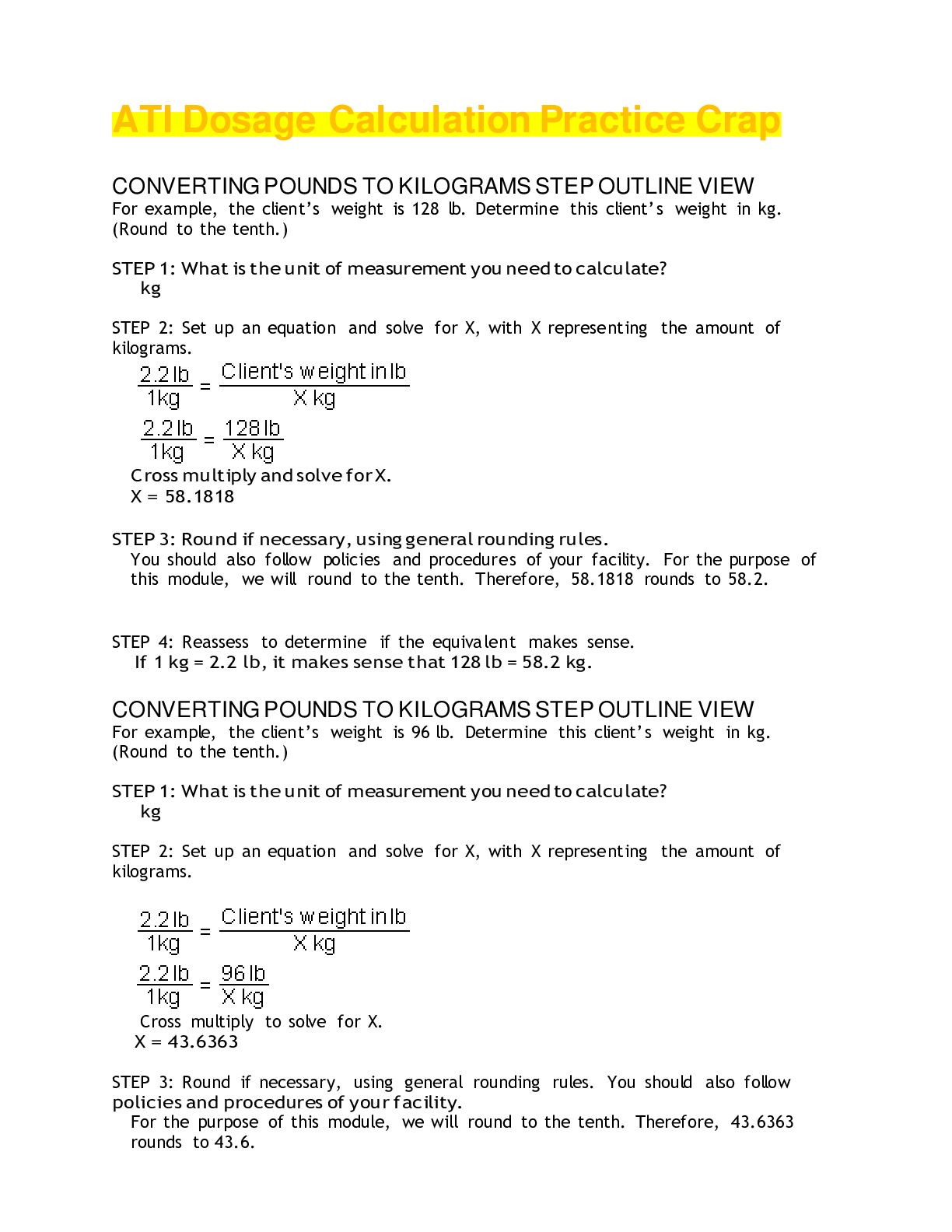
Reviews( 0 )
Document information
Connected school, study & course
About the document
Uploaded On
Jun 26, 2021
Number of pages
48
Written in
Additional information
This document has been written for:
Uploaded
Jun 26, 2021
Downloads
0
Views
34


.png)
